1. Spring6 的JdbcTemplate的JDBC模板类的详细使用说明
文章目录
- 1. Spring6 的JdbcTemplate的JDBC模板类的详细使用说明
- 每博一文案
- 2. 环境准备
- 3. 数据准备
- 4. 开始
- 4.1 从数据表中插入(添加)数据
- 4.2 从数据表中修改数据
- 4.3 从数据表中删除数据
- 4.4 从数据表中查询一个对象
- 4.5 从数据表中查询一个值
- 4.6 从数据表中查询多条记录
- 4.7 从数据表中批量添加数据
- 4.8 从数据表中批量修改数据
- 4.9 从数据表中批量删除数据
- 4.10 JdbcTemplate 使用回调函数
- 4.11 JdbcTemplate 配合使用上德鲁伊连接池
- 5. 总结:
- 6. 最后:
每博一文案
他伸直双臂,举过头顶,两只手握在一起,伸了个懒腰,望着天地交接的地方,声音飘渺,嗯,有人说高中喜欢的人是能记一辈子的。
你信吗?
他侧着头望着他,邢武对他笑,笑得那么云淡风轻,眼神却那么复杂,声音透过风有些不真切地传了过去。
你这么优秀,不能回在感情上。
那一瞬间,晴也身上仿佛迸发出耀眼自信的光芒,转过身,逆着光昂起下巴说,一辈子很长,可以做很多事,但我不会把它用来记住一个人。
我晴也不可能毁在任何事情上。
信我,我不是懦夫。
如果我敢拿未来赌一把,你会让我输吗?
晴也把选择权重新拾了起来,郑重地交还到邢武手中。
他知道邢武的担忧和闪躲,也知道他的顾虑和徘徊。
无论是他的家庭,他的出身,他的背景,让他不敢去想以后。
所以晴也把自己的决心赤裸裸地洒在这片戈壁滩上,让他清晰地感受着,神情凝重地望着邢武,身影被夕阳拉得颀长,那一刻,他只感觉到一股强大的力量撞进他的心脏。
仿佛藏着排山倒海的光束向他奔腾而来,那么强烈,那么坚定。
他的生命中从来没有出现过这样一个人,一个不惧天地万物,不怕世俗捆绑的女孩儿,一个浑身是光让他看见未来的女孩儿。
一个充满智慧,勇敢,把命运牢牢攥在手中的女孩儿。
他忽然很怕眼前的这个女孩儿,怕过了这辈子就再也遇不到了。
如果他都敢赌,他又有什么理由退缩呢?——————《耀眼》
JdbcTemplate 是Spring 提供的一个JDBC模板类,是对JDBC的封装,简化JDBC代码,当然,你也可以不用,可以让Spring集成其它的ORM框架,例如:MyBatis,Hibernate 等。其中JDBC关于数据库的连接也是一个重要的内容,想要了解更多的大家可以移步至:✏️✏️✏️ JDBC_ChinaRainbowSea的博客-CSDN博客
下面我们正式开始对 JdbcTemplate 上的学习,完成增删改查。
2. 环境准备
这里,我们新建一个模块,方便学习,如下:因为我们这里是Spring6,而Spring6最低支持的JDK是17,所以我这里是 JDK17的。
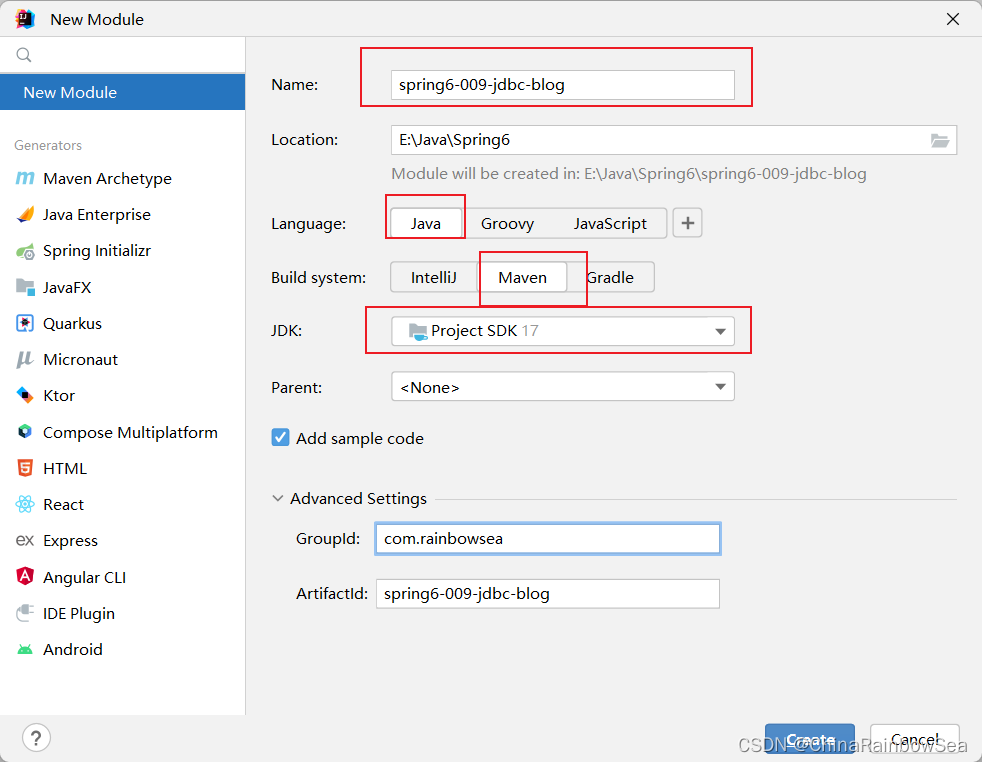
新建好模块以后,我们需要导入相关的依赖,这里我们通过 maven 导入依赖。关于Maven 的内容呢,大家可以移步至:✏️✏️✏️Maven_ChinaRainbowSea的博客-CSDN博客 ,进行更多的学习了解
具体的依赖有:
- spring context 依赖 (spring6 的依赖)
- mysql-connector-java(关于MySQL驱动的依赖,因为我们要连接数据库,这里我们连接的是MySQL数据库)
- spring-jdbc (spring jdbc,这个依赖中有JdbcTemplate)
- junit (Junit4 单元测试依赖)
特殊的还有这个,也得添加上
<repositories><repository><id>repository.spring.milestone</id><name>Spring Milestone Repository</name><url>https://repo.spring.io/milestone</url></repository></repositories>
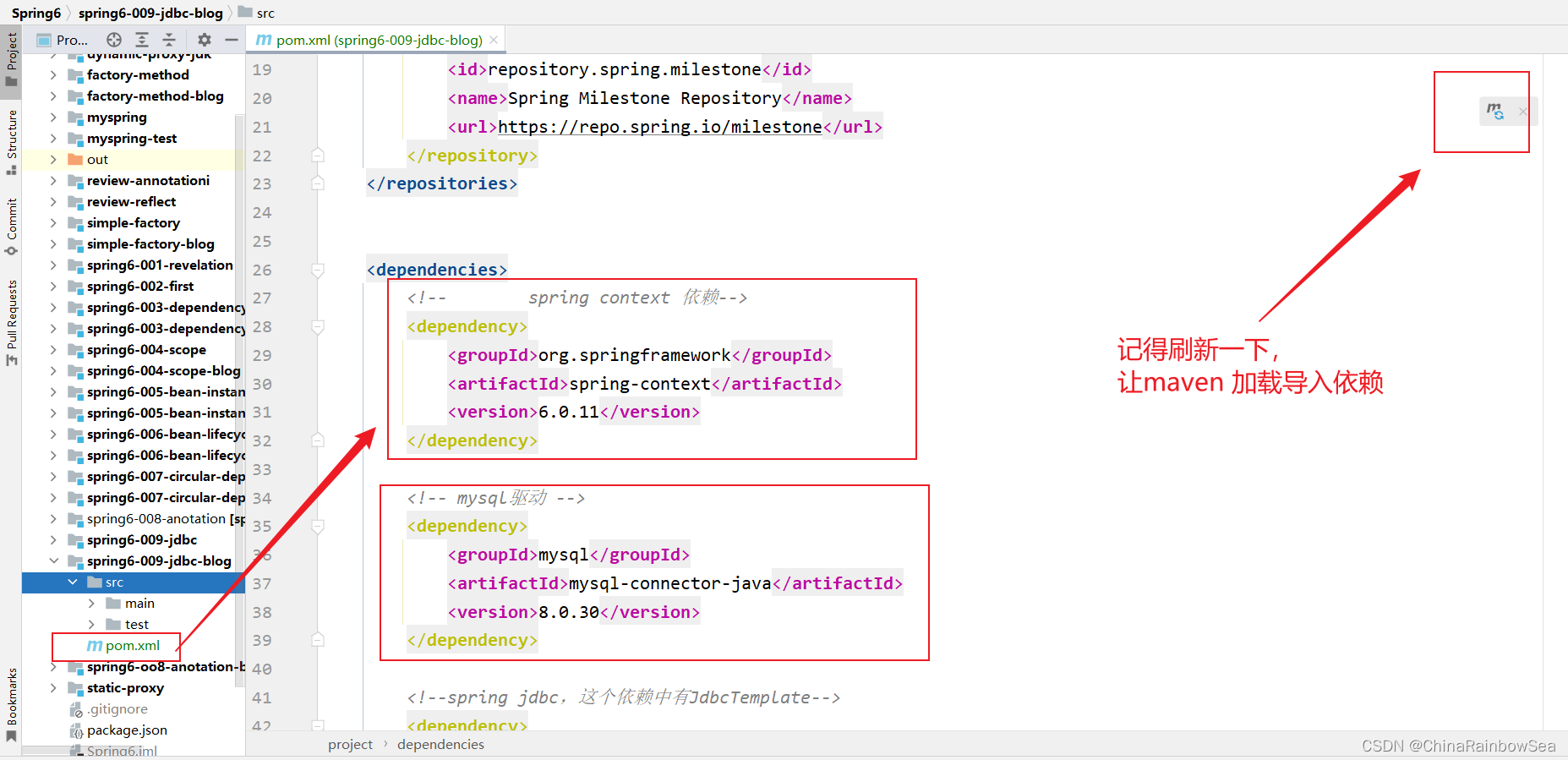
<?xml version="1.0" encoding="UTF-8"?>
<project xmlns="http://maven.apache.org/POM/4.0.0"xmlns:xsi="http://www.w3.org/2001/XMLSchema-instance"xsi:schemaLocation="http://maven.apache.org/POM/4.0.0 http://maven.apache.org/xsd/maven-4.0.0.xsd"><modelVersion>4.0.0</modelVersion><groupId>com.rainbowsea</groupId><artifactId>spring6-009-jdbc-blog</artifactId><version>1.0-SNAPSHOT</version><properties><maven.compiler.source>17</maven.compiler.source><maven.compiler.target>17</maven.compiler.target></properties><repositories><repository><id>repository.spring.milestone</id><name>Spring Milestone Repository</name><url>https://repo.spring.io/milestone</url></repository></repositories><dependencies><!-- spring context 依赖--><dependency><groupId>org.springframework</groupId><artifactId>spring-context</artifactId><version>6.0.11</version></dependency><!-- mysql驱动 --><dependency><groupId>mysql</groupId><artifactId>mysql-connector-java</artifactId><version>8.0.30</version></dependency><!--spring jdbc,这个依赖中有JdbcTemplate--><dependency><groupId>org.springframework</groupId><artifactId>spring-jdbc</artifactId><version>6.0.0-M2</version></dependency><!-- junit4 --><dependency><groupId>junit</groupId><artifactId>junit</artifactId><version>4.13.2</version><scope>test</scope></dependency></dependencies></project>
3. 数据准备
首先,我们创建一个名为 spring6的数据库,想要了解SQL语句的内容的,大家可以移步至✏️✏️✏️ SQL语法学习_ChinaRainbowSea的博客-CSDN博客
/* 判断该数据库是否存在,不存在,创建*/
CREATE DATABASE IF NOT EXISTS spring6;
然后在 spring6 数据库中创建一个名为 user 的数据表
CREATE TABLE `user` (`id` int NOT NULL AUTO_INCREMENT,`real_name` varchar(255) ,`age` int ,PRIMARY KEY (`id`) USING BTREE
) ;-- ----------------------------
-- Records of user
-- ----------------------------
INSERT INTO `user` VALUES (1, '李四', 33);
INSERT INTO `user` VALUES (2, '李华', 20);
INSERT INTO `user` VALUES (3, '李华', 21);

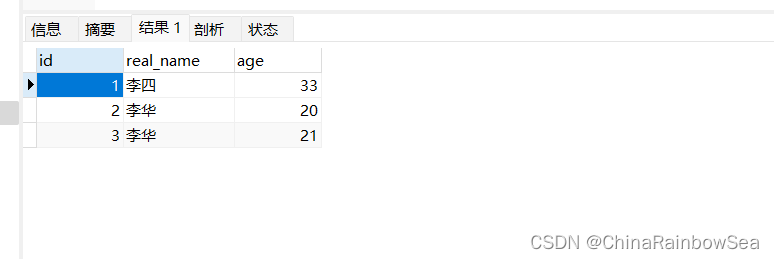
准备实体类:表user对应的实体类User。根据user 数据表结构创建对于的Bean 实体类。
注意: 这里我们定义用对应简单类型的包装类,来定义成员变量,防止数据库的数值为Null时,报错,中断。
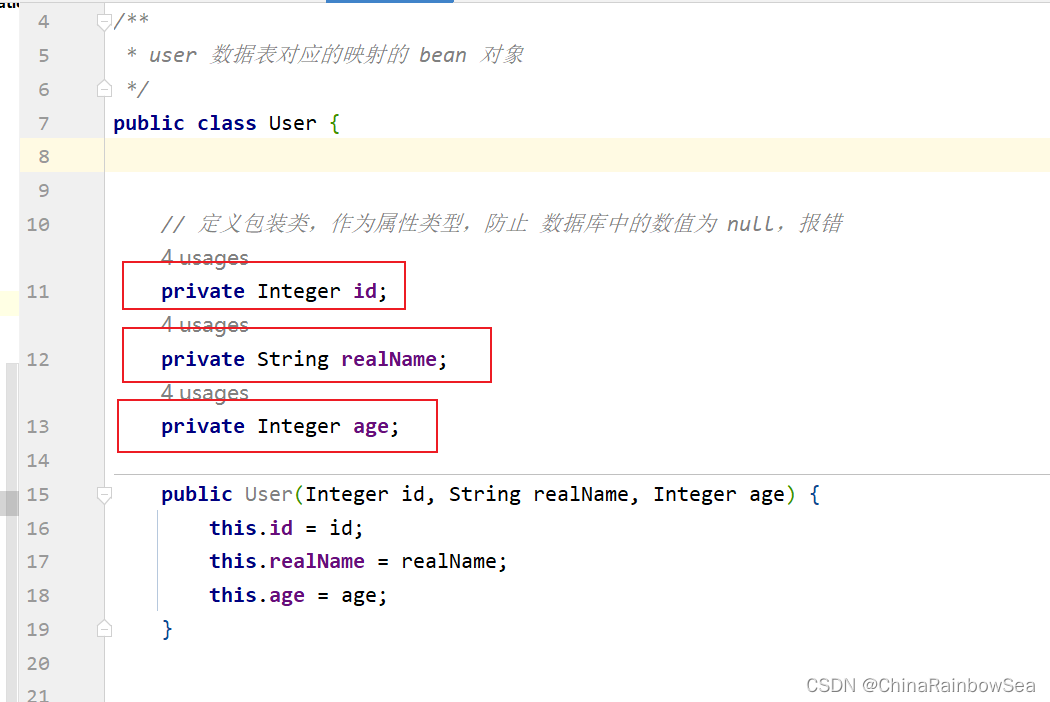
package com.rainbowsea.spring6.bean;/*** user 数据表对应的映射的 bean 对象*/
public class User {// 定义包装类,作为属性类型,防止 数据库中的数值为 null,报错private Integer id;private String realName;private Integer age;public User(Integer id, String realName, Integer age) {this.id = id;this.realName = realName;this.age = age;}public User() {}public Integer getId() {return id;}public void setId(Integer id) {this.id = id;}public String getRealName() {return realName;}public void setRealName(String realName) {this.realName = realName;}public Integer getAge() {return age;}public void setAge(Integer age) {this.age = age;}@Overridepublic String toString() {return "User{" +"id=" + id +", realName='" + realName + '\'' +", age=" + age +'}';}
}配置编写相关的spring.xml的信息
JdbcTemplate 是Spring 提供好的类,这类的完整类名是:org.springframework.jdbc.core.JdbcTemplate 。这个类上的使用,我们 new 对象就好了,而Spring 可以帮我们 new 对象,所以,我们就将这个new JdbcTemplate 对象这件事交给 Spring 来做。直接将这个类配置到
spring.xml的配置文件当中,纳入 Bean管理即可。
我们来看一下这个JdbcTemplate源码:
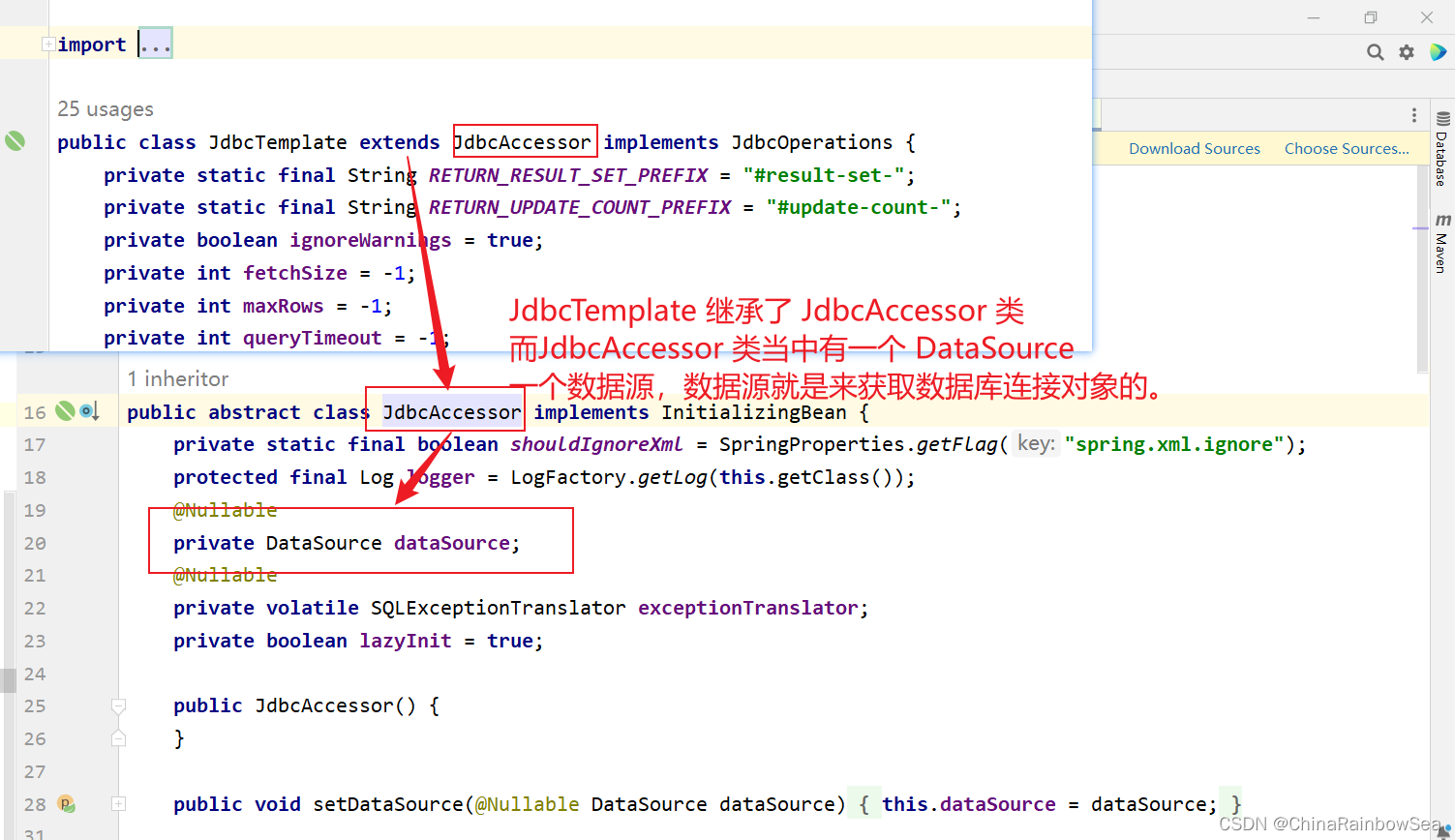
所以这里,我们只需要配置好 DataSource 数据源,用来连接数据库即可,将DataSource 属性进行 set 注入赋值上。可以看到JdbcTemplate中有一个DataSource属性,这个属性是数据源,我们都知道连接数据库需要Connection对象,而生成Connection对象是数据源负责的。所以我们需要给JdbcTemplate设置数据源属性。
所有的数据源都是要实现javax.sql.DataSource接口的。这个数据源可以自己写一个,也可以用写好的,比如:阿里巴巴的德鲁伊连接池,c3p0,dbcp等。我们这里自己先手写一个数据源。
自己的数据源,数据源存在的目的是为了提供 Connection 对象;只要实现了DataSource 接口的都是数据源:德鲁伊连接池,C3p0连接池,dbcp连接池,都实现了DataSource 接口
如下:
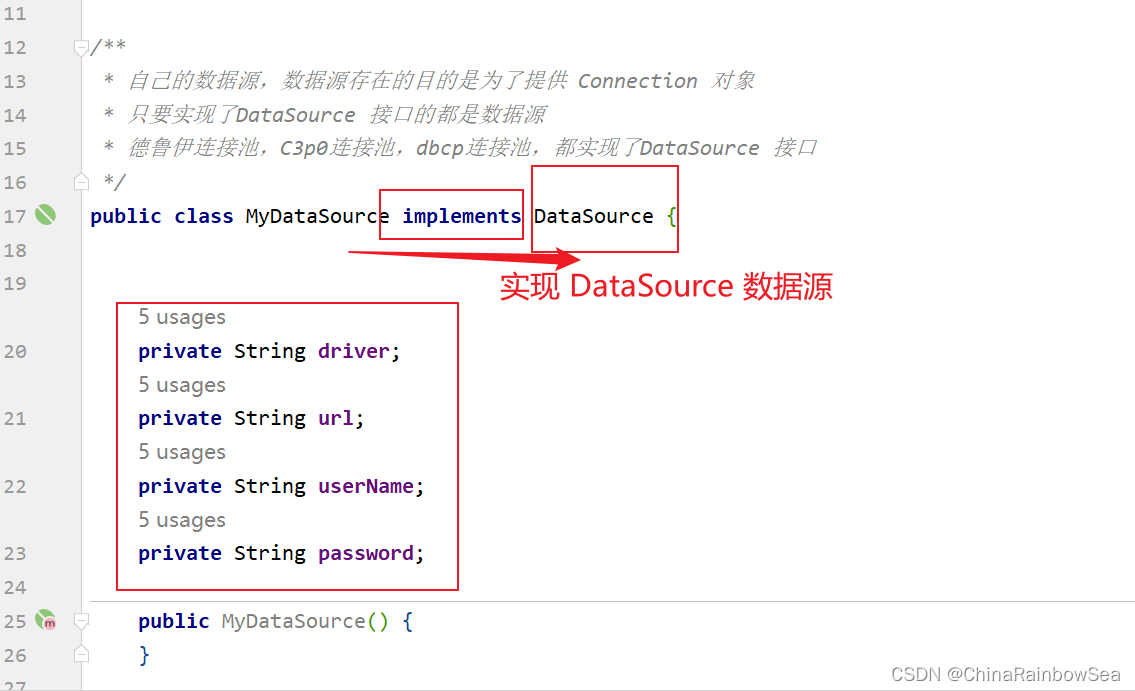
重写其中的**public Connection getConnection() throws SQLException ** 方法,注意是没有参数的。
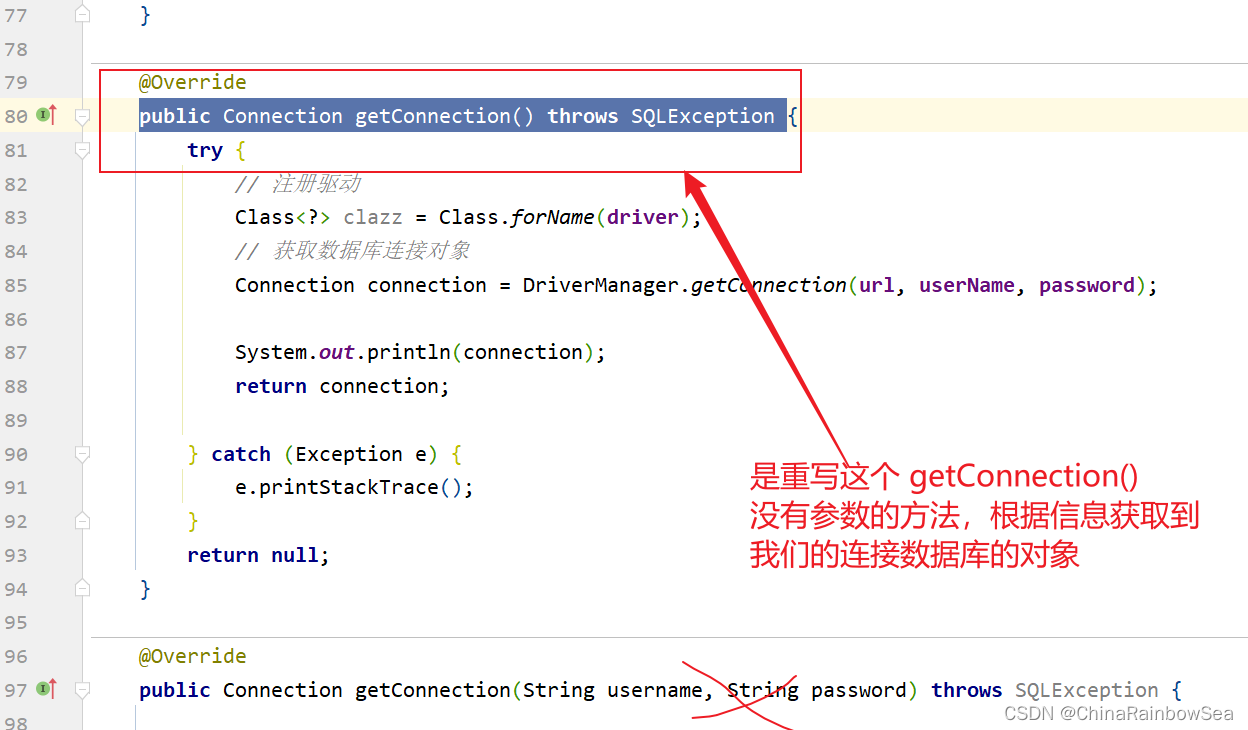
@Overridepublic Connection getConnection() throws SQLException {try {// 注册驱动Class<?> clazz = Class.forName(driver);// 获取数据库连接对象Connection connection = DriverManager.getConnection(url, userName, password);System.out.println(connection);return connection;} catch (Exception e) {e.printStackTrace();}return null;}
package com.rainbowsea.spring6.bean;import javax.sql.DataSource;
import java.io.PrintWriter;
import java.sql.Connection;
import java.sql.DriverManager;
import java.sql.SQLException;
import java.sql.SQLFeatureNotSupportedException;
import java.util.logging.Logger;/*** 自己的数据源,数据源存在的目的是为了提供 Connection 对象* 只要实现了DataSource 接口的都是数据源* 德鲁伊连接池,C3p0连接池,dbcp连接池,都实现了DataSource 接口*/
public class MyDataSource implements DataSource {private String driver;private String url;private String userName;private String password;public MyDataSource() {}public MyDataSource(String driver, String url, String userName, String password) {this.driver = driver;this.url = url;this.userName = userName;this.password = password;}public String getDriver() {return driver;}public void setDriver(String driver) {this.driver = driver;}public String getUrl() {return url;}public void setUrl(String url) {this.url = url;}public String getUserName() {return userName;}public void setUserName(String userName) {this.userName = userName;}public String getPassword() {return password;}public void setPassword(String password) {this.password = password;}@Overridepublic String toString() {return "MyDataSource{" +"driver='" + driver + '\'' +", url='" + url + '\'' +", userName='" + userName + '\'' +", password='" + password + '\'' +'}';}@Overridepublic Connection getConnection() throws SQLException {try {// 注册驱动Class<?> clazz = Class.forName(driver);// 获取数据库连接对象Connection connection = DriverManager.getConnection(url, userName, password);System.out.println(connection);return connection;} catch (Exception e) {e.printStackTrace();}return null;}@Overridepublic Connection getConnection(String username, String password) throws SQLException {return null;}@Overridepublic PrintWriter getLogWriter() throws SQLException {return null;}@Overridepublic void setLogWriter(PrintWriter out) throws SQLException {}@Overridepublic void setLoginTimeout(int seconds) throws SQLException {}@Overridepublic int getLoginTimeout() throws SQLException {return 0;}@Overridepublic Logger getParentLogger() throws SQLFeatureNotSupportedException {return null;}@Overridepublic <T> T unwrap(Class<T> iface) throws SQLException {return null;}@Overridepublic boolean isWrapperFor(Class<?> iface) throws SQLException {return false;}
}写完数据源,我们需要把这个数据源传递给JdbcTemplate。因为JdbcTemplate中有一个DataSource属性;同时获取为该 DataSource 数据源,通过Spring的set 注入,为其中的成员变量赋值。就是连接我们MySQL数据库的一些信息。如下:
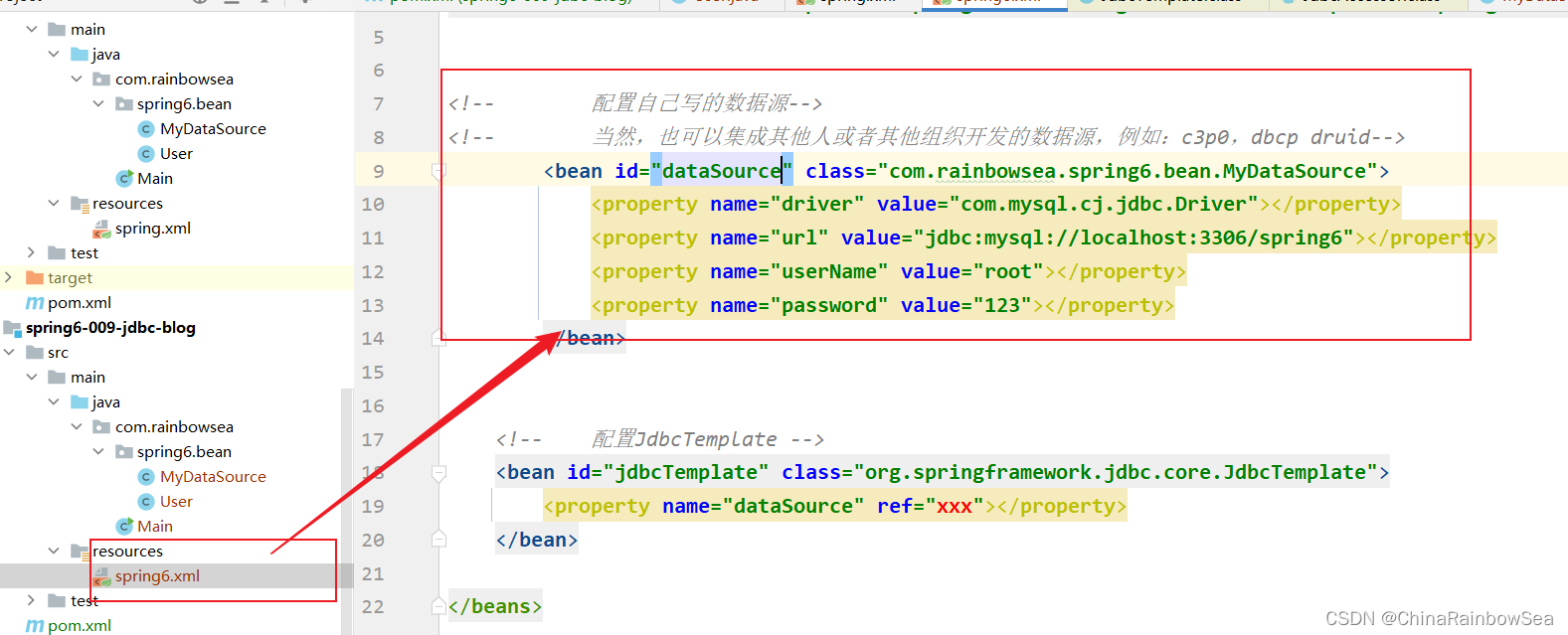
<!-- 配置自己写的数据源-->
<!-- 当然,也可以集成其他人或者其他组织开发的数据源,例如:c3p0,dbcp druid--><bean id="dataSource" class="com.rainbowsea.spring6.bean.MyDataSource"><property name="driver" value="com.mysql.cj.jdbc.Driver"></property><property name="url" value="jdbc:mysql://localhost:3306/spring6"></property><property name="userName" value="root"></property><property name="password" value="123"></property></bean>
这时候,我们就可以将这个数据源传递给JdbcTemplate。因为JdbcTemplate中有一个DataSource属性。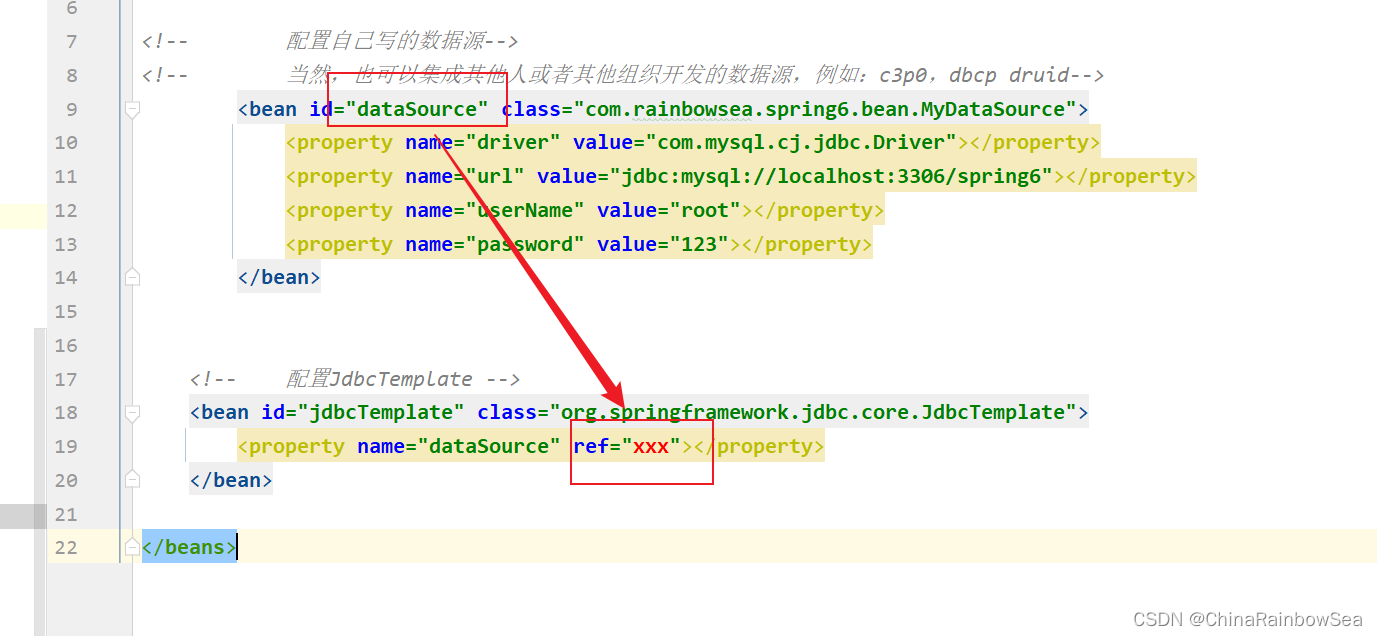
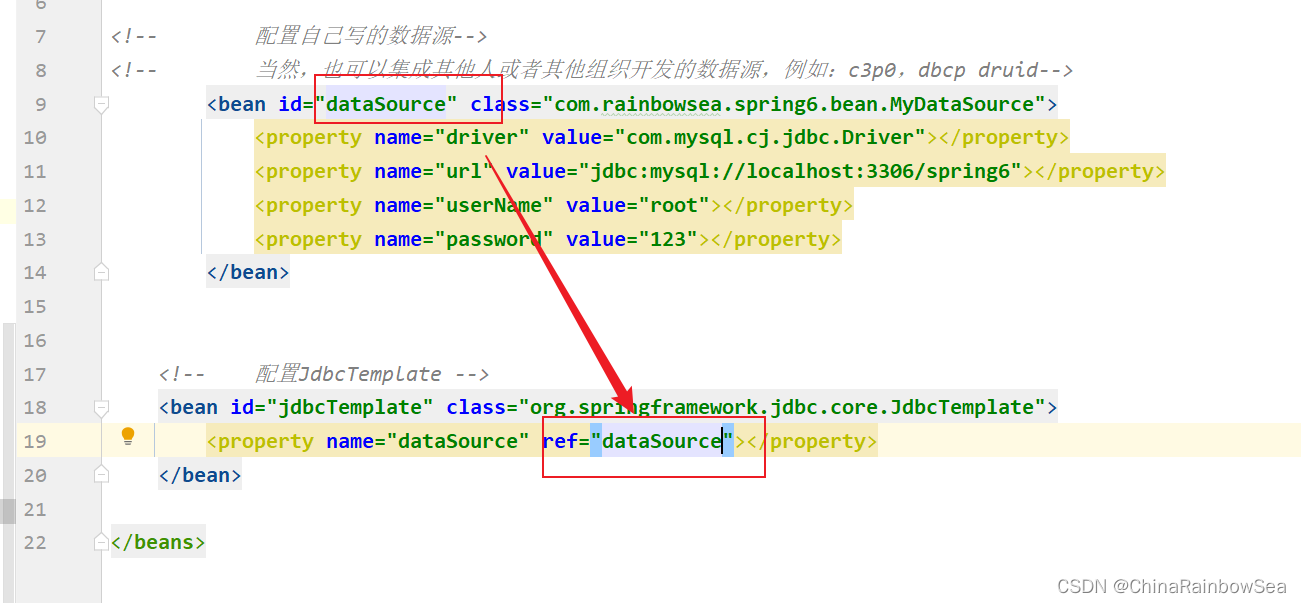
<?xml version="1.0" encoding="UTF-8"?>
<beans xmlns="http://www.springframework.org/schema/beans"xmlns:xsi="http://www.w3.org/2001/XMLSchema-instance"xsi:schemaLocation="http://www.springframework.org/schema/beans http://www.springframework.org/schema/beans/spring-beans.xsd"><!-- 配置自己写的数据源-->
<!-- 当然,也可以集成其他人或者其他组织开发的数据源,例如:c3p0,dbcp druid--><bean id="dataSource" class="com.rainbowsea.spring6.bean.MyDataSource"><property name="driver" value="com.mysql.cj.jdbc.Driver"></property><property name="url" value="jdbc:mysql://localhost:3306/spring6"></property><property name="userName" value="root"></property><property name="password" value="123"></property></bean><!-- 配置JdbcTemplate --><bean id="jdbcTemplate" class="org.springframework.jdbc.core.JdbcTemplate"><property name="dataSource" ref="dataSource"></property></bean></beans>
这里,我们的环境准备好了,数据表也准备好了,下面就可以开始通过Spring 的JdbcTemplate 操作数据库了(对数据库进行增删改查)的操作了。具体内容如下。
4. 开始
4.1 从数据表中插入(添加)数据
首先,我们通过 Spring 读取上面我们配置好的spinrg.xml 文件当中的,从而实例化 JdbcTemplate 类对象。
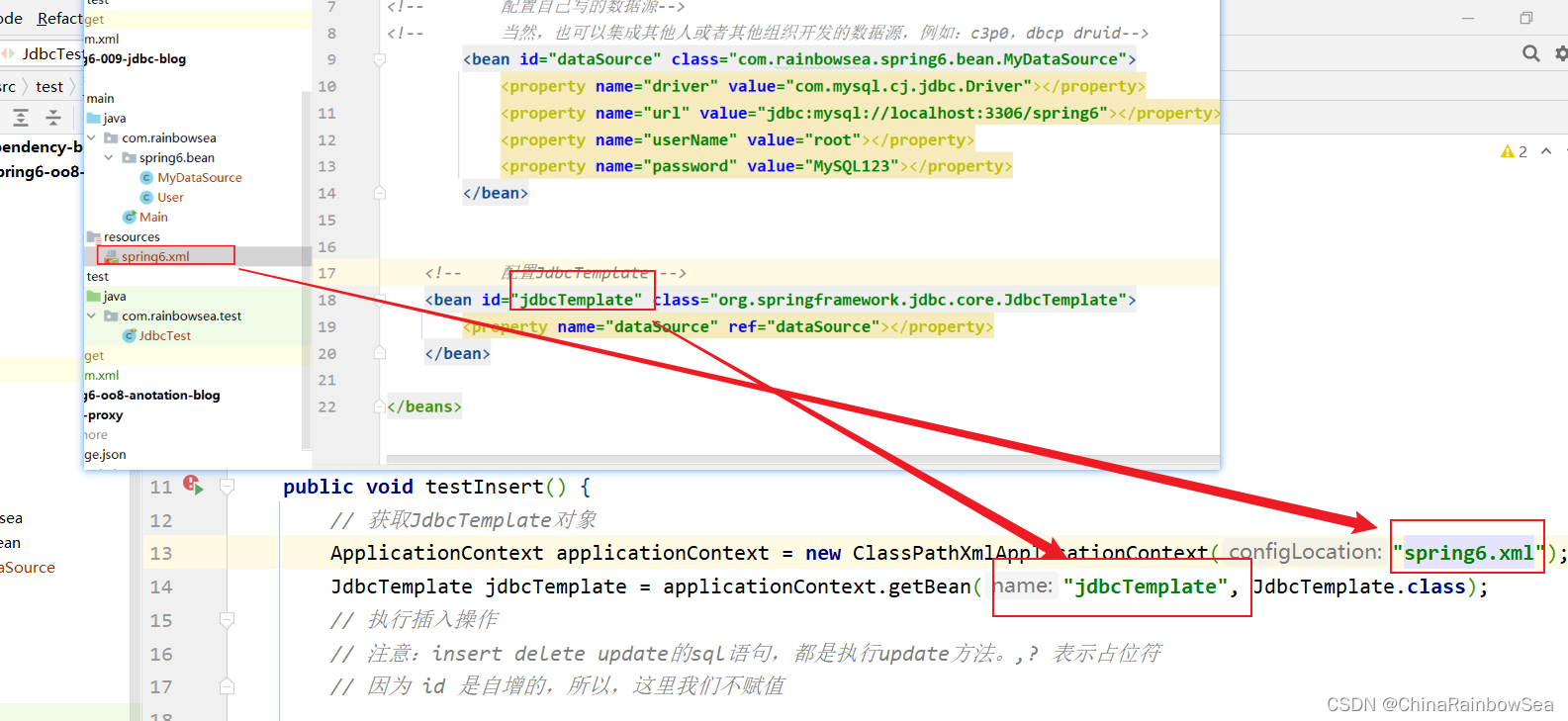
然后使用:jdbcTemplate.update() 的方法,执行SQL语句。
需要注意的是:在Spring当中的JdbcTemplate,对于数据库上的增删改,执行SQL语句都是使用update() 的方法处理的。
第一个参数:String sql
第二个参数: @Nullable Object… args 是一个可变参数(是一个数组),表示
表示:SQL语句当中的
?占位符的要填入的值。
返回值:int 表示修改/更新的记录条数。



package com.rainbowsea.test;import org.junit.Test;
import org.springframework.context.ApplicationContext;
import org.springframework.context.support.ClassPathXmlApplicationContext;
import org.springframework.jdbc.core.JdbcTemplate;public class JdbcTest {@Testpublic void testInsert() {// 获取JdbcTemplate对象ApplicationContext applicationContext = new ClassPathXmlApplicationContext("spring6.xml");JdbcTemplate jdbcTemplate = applicationContext.getBean("jdbcTemplate", JdbcTemplate.class);// 执行插入操作// 注意:insert delete update的sql语句,都是执行update方法。,? 表示占位符// 因为 id 是自增的,所以,这里我们不赋值String sql = "insert into user(real_name,age) values(?,?)";// 返回修改的记录条数int count = jdbcTemplate.update(sql, "张三", 30);System.out.println("插入的记录条数:" + count);}
}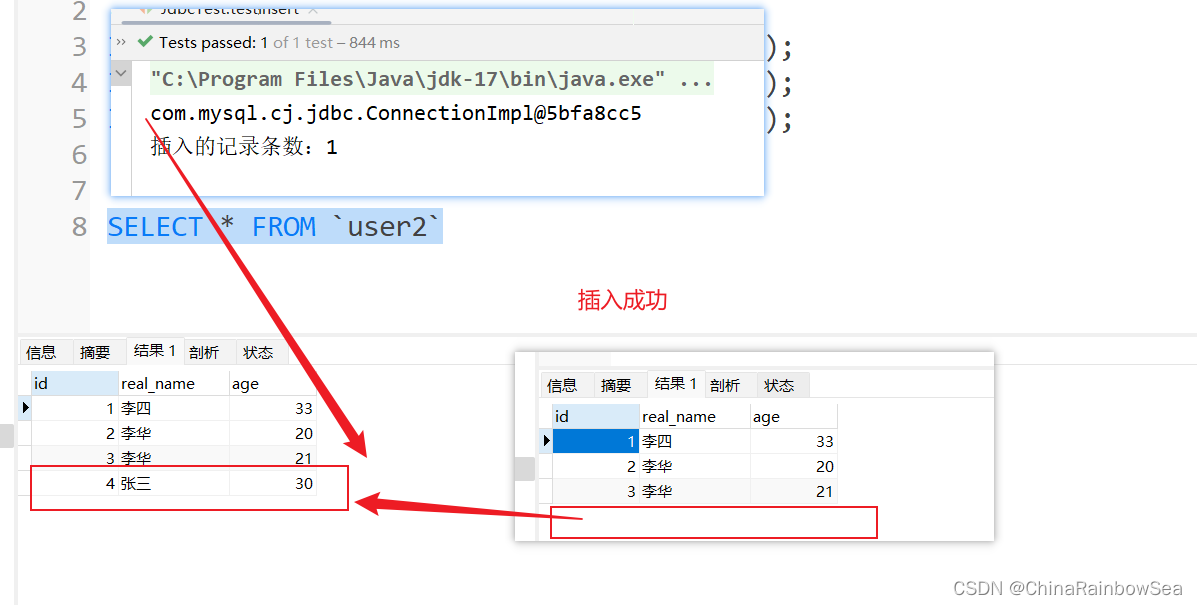
4.2 从数据表中修改数据
在Spring当中的JdbcTemplate,对于数据库上的增删改,执行SQL语句都是使用update() 的方法处理的。
我们这里:将id 为1的,real_name修改为:张小六,age 为 18

package com.rainbowsea.test;import org.junit.Test;
import org.springframework.context.ApplicationContext;
import org.springframework.context.support.ClassPathXmlApplicationContext;
import org.springframework.jdbc.core.JdbcTemplate;public class JdbcTest {@Testpublic void testUpdate() {// 获取JdbcTemplate对象ApplicationContext applicationContext = new ClassPathXmlApplicationContext("spring6.xml");JdbcTemplate jdbcTemplate = applicationContext.getBean("jdbcTemplate", JdbcTemplate.class);// 执行插入操作// 注意:insert delete update的sql语句,都是执行update方法。,? 表示占位符// 执行更新操作String sql = "update user2 set real_name = ?, age = ? where id = ?";int count = jdbcTemplate.update(sql, "张小六", 18, 1);System.out.println(count);}
}
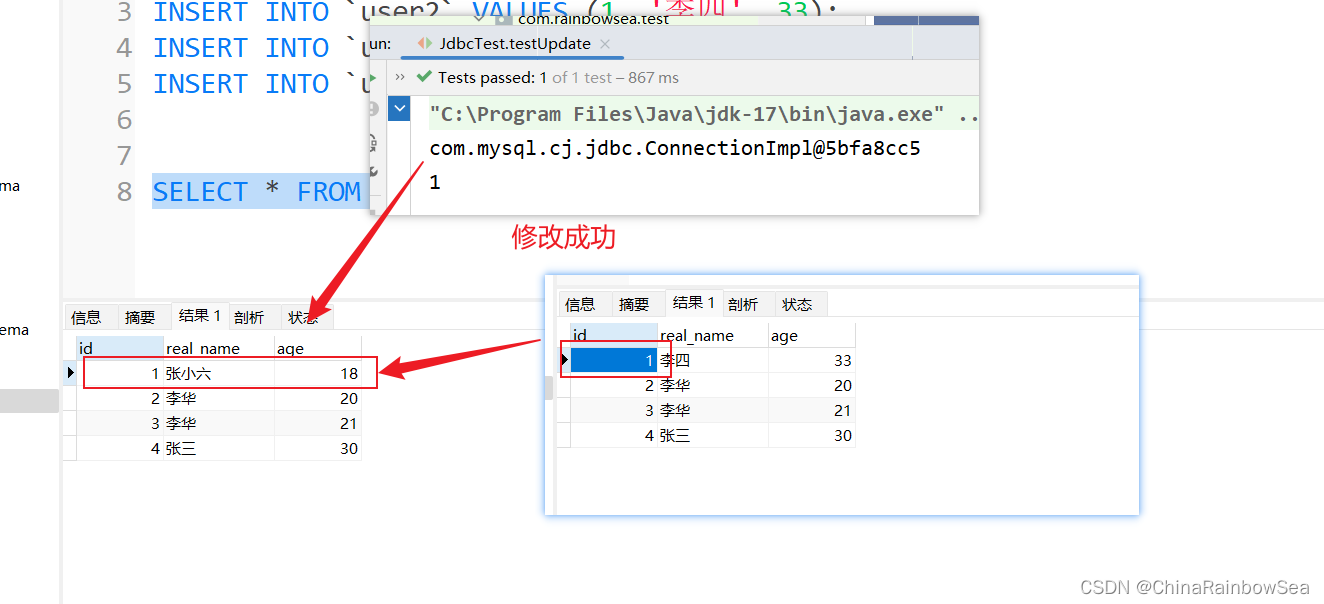
4.3 从数据表中删除数据
在Spring当中的JdbcTemplate,对于数据库上的增删改,执行SQL语句都是使用update() 的方法处理的。
我们这里:将id 为4的一条记录删除了。
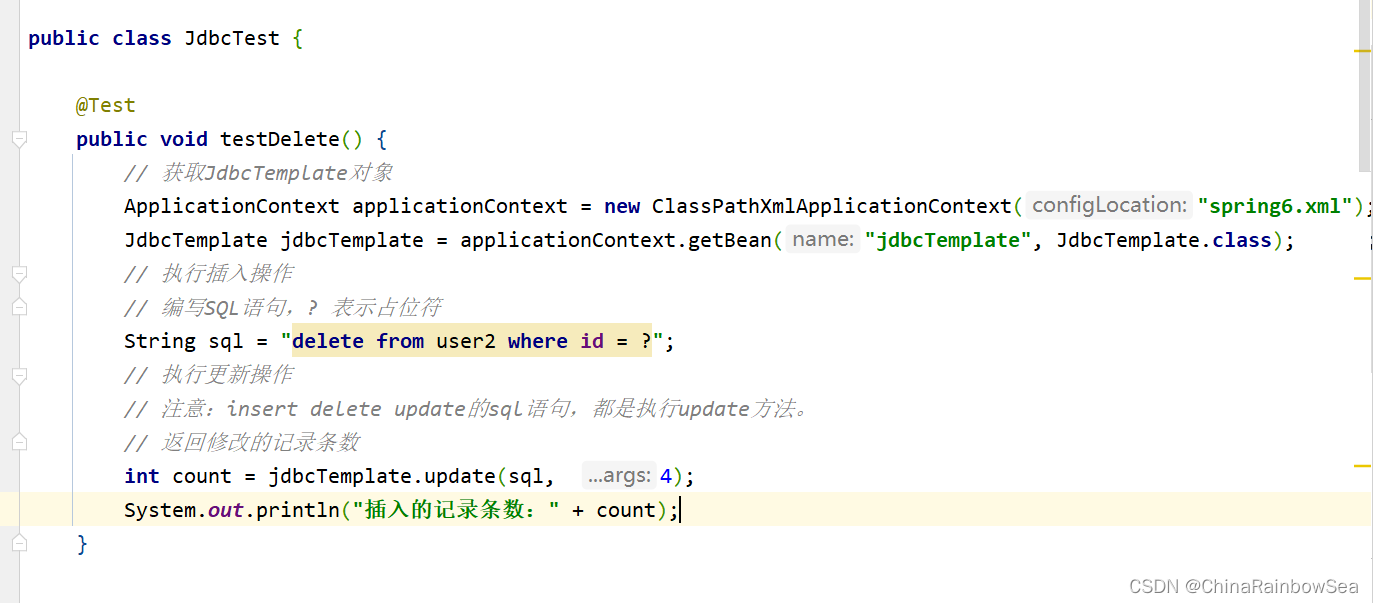
package com.rainbowsea.test;import org.junit.Test;
import org.springframework.context.ApplicationContext;
import org.springframework.context.support.ClassPathXmlApplicationContext;
import org.springframework.jdbc.core.JdbcTemplate;public class JdbcTest {@Testpublic void testDelete() {// 获取JdbcTemplate对象ApplicationContext applicationContext = new ClassPathXmlApplicationContext("spring6.xml");JdbcTemplate jdbcTemplate = applicationContext.getBean("jdbcTemplate", JdbcTemplate.class);// 执行插入操作// 编写SQL语句,? 表示占位符String sql = "delete from user2 where id = ?";// 执行更新操作// 注意:insert delete update的sql语句,都是执行update方法。// 返回修改的记录条数int count = jdbcTemplate.update(sql, 4);System.out.println("插入的记录条数:" + count);}
}

4.4 从数据表中查询一个对象
关于查询一条记录,使用 jdbcTemplate.queryForObject() 方法:

第一个参数:String sql 要执行的SQL语句
第二个参数:BeanPropertyRowMapper 与对应数据库表中 bean 类的相映射的类。一般用: new BeanPropertyRowMapper<>(T.class) 这样的对象装配上。Bean属性值和数据库记录行的映射对象。在构造方法中指定映射的对象类型。
第三个参数:SQL语句当中的
?占位符。可变长参数,给sql语句的占位符问号传值。返回值:运用了泛型,也就是对应数据库表中在Java当中相对应,映射的 bean 类。

这里我们查询一个id为1的,其中的ID,real_name,age 的一条记录

import com.rainbowsea.spring6.bean.User;
import org.junit.Test;
import org.springframework.context.ApplicationContext;
import org.springframework.context.support.ClassPathXmlApplicationContext;
import org.springframework.jdbc.core.BeanPropertyRowMapper;
import org.springframework.jdbc.core.JdbcTemplate;public class JdbcTest {@Testpublic void testSelectOne() {// 获取JdbcTemplate对象ApplicationContext applicationContext = new ClassPathXmlApplicationContext("spring6.xml");JdbcTemplate jdbcTemplate = applicationContext.getBean("jdbcTemplate", JdbcTemplate.class);// 执行插入操作// 编写SQL语句,? 表示占位符String sql = "select id, real_name, age from user2 where id = ?";// 执行更新操作// 返回对应查询到的 Bean 类User user = jdbcTemplate.queryForObject(sql, new BeanPropertyRowMapper<>(User.class), 1);System.out.println(user);}
}
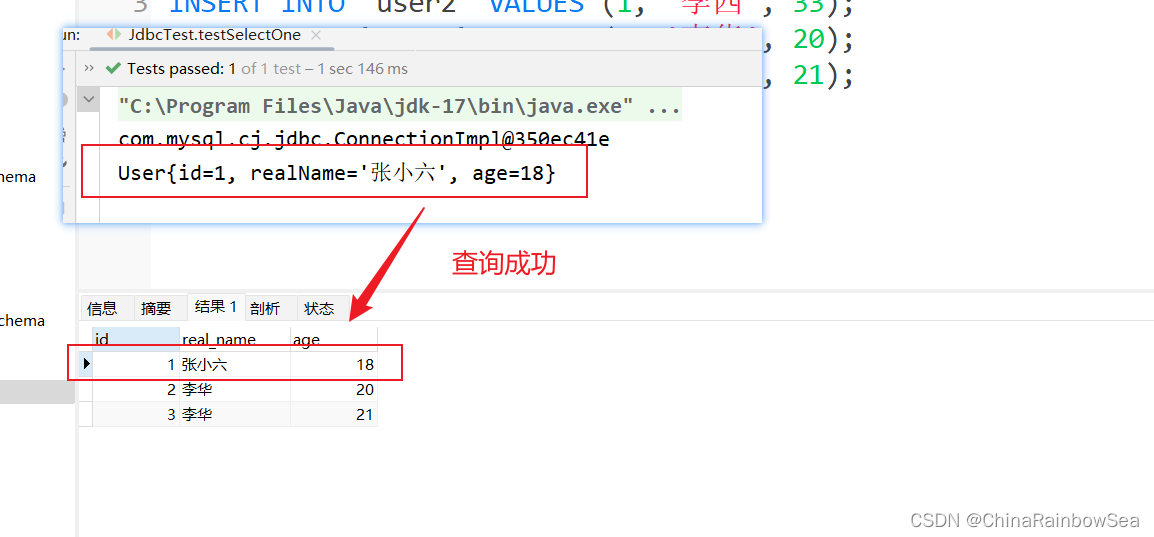
4.5 从数据表中查询一个值
查询数据表当中有几条记录,对应查询数据表中的一个值的内容,我们同样还是使用:jdbcTemplate.queryForObject() 方法来进行。不同的是,这个参数是两个的,是对应的类对象,
- 比如这里我们查询的是一个数据表中有几条记录,几条记录,就是一个值了,一个数值类型的类对象了,可以是 int.class,也可以是 long.class,还可以是 short.class 因为只要是数值类型就可以了。
- 返回值是对应类的包装类,

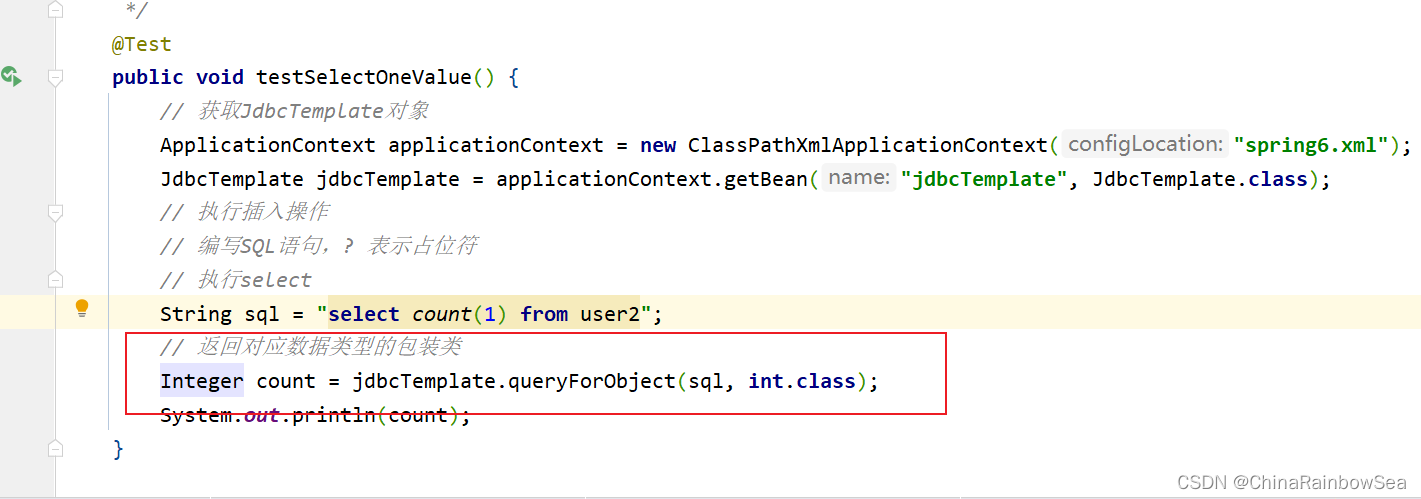
import com.rainbowsea.spring6.bean.User;
import org.junit.Test;
import org.springframework.context.ApplicationContext;
import org.springframework.context.support.ClassPathXmlApplicationContext;
import org.springframework.jdbc.core.BeanPropertyRowMapper;
import org.springframework.jdbc.core.JdbcTemplate;import java.util.List;public class JdbcTest {/*** 查询数据表中的一个值*/@Testpublic void testSelectOneValue() {// 获取JdbcTemplate对象ApplicationContext applicationContext = new ClassPathXmlApplicationContext("spring6.xml");JdbcTemplate jdbcTemplate = applicationContext.getBean("jdbcTemplate", JdbcTemplate.class);// 执行插入操作// 编写SQL语句,? 表示占位符// 执行selectString sql = "select count(1) from user2";// 返回对应数据类型的包装类Integer count = jdbcTemplate.queryForObject(sql, int.class);System.out.println(count);}
}
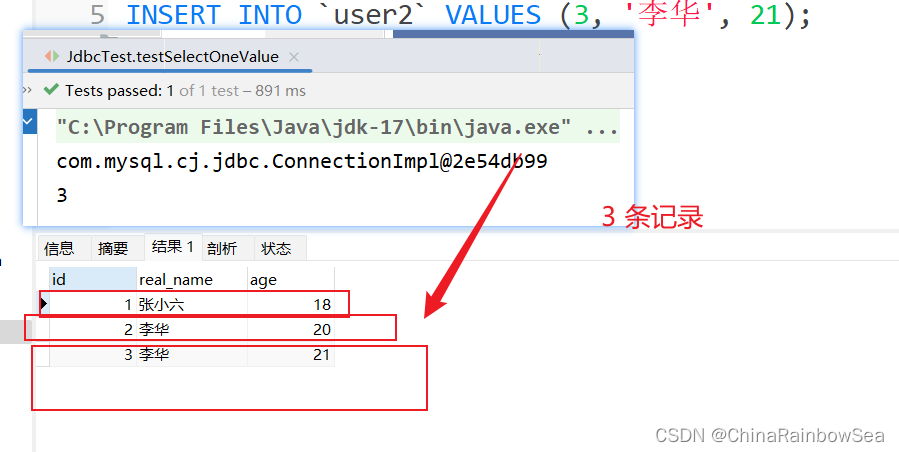
用 Long.class 也是可以的。
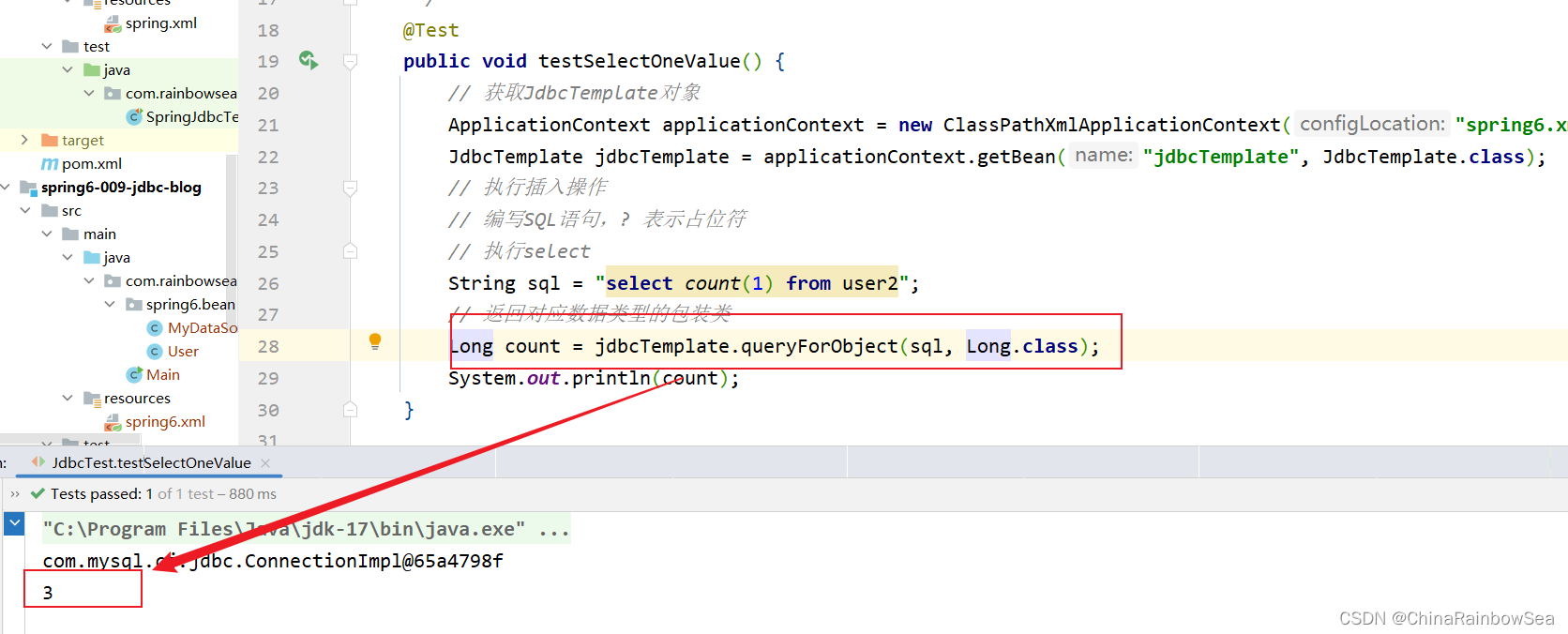
4.6 从数据表中查询多条记录
查询数据表中的多个对象,我们就要使用:jdbcTemplate.query() 方法了
- 第一个参数:同样还是:要执行的SQL语句
- 第二个参数:。Bean属性值和数据库记录行的映射对象。在构造方法中指定映射的对象类型。;BeanPropertyRowMapper 与对应数据库表中 bean 类的相映射的类。一般用: new BeanPropertyRowMapper<>(T.class) 这样的对象装配上。
- 返回值:是一个List 集合了,因为我们查询到的多条记录,自然就是存储到集合当中去了。

这里我们查询,user2 表中的所有用户的所有信息。
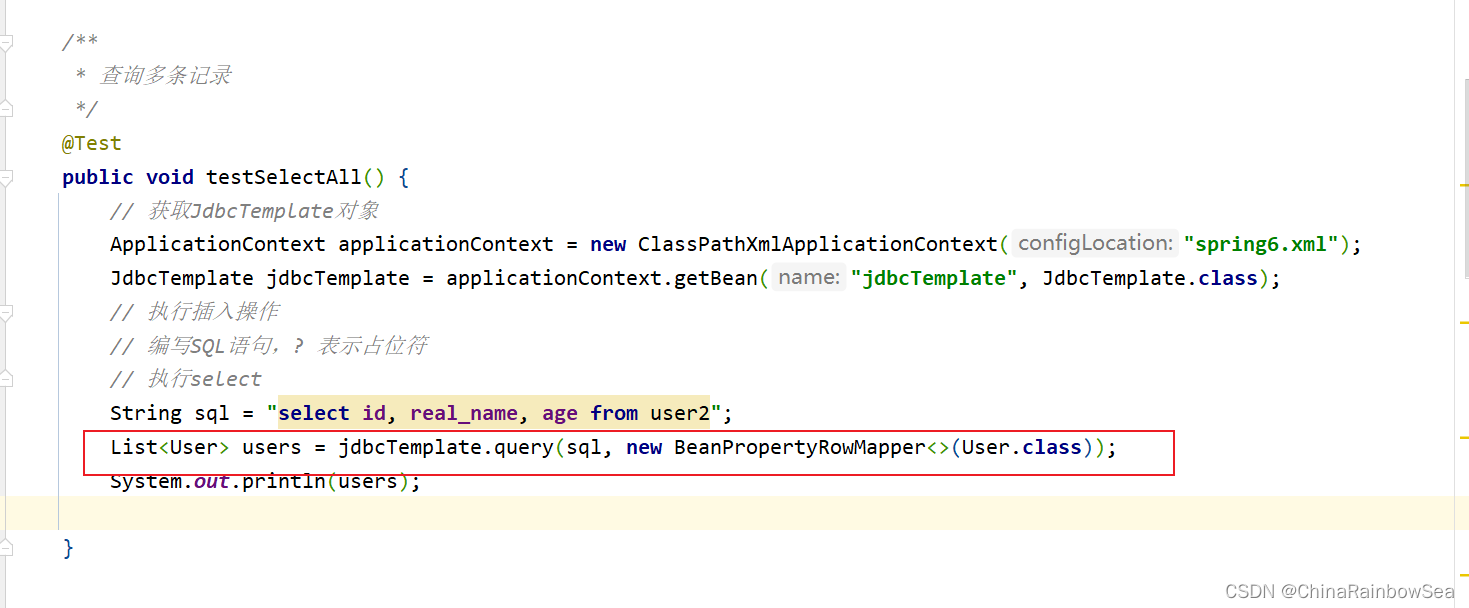
import com.rainbowsea.spring6.bean.User;
import org.junit.Test;
import org.springframework.context.ApplicationContext;
import org.springframework.context.support.ClassPathXmlApplicationContext;
import org.springframework.jdbc.core.BeanPropertyRowMapper;
import org.springframework.jdbc.core.JdbcTemplate;import java.util.List;public class JdbcTest {/*** 查询多条记录*/@Testpublic void testSelectAll() {// 获取JdbcTemplate对象ApplicationContext applicationContext = new ClassPathXmlApplicationContext("spring6.xml");JdbcTemplate jdbcTemplate = applicationContext.getBean("jdbcTemplate", JdbcTemplate.class);// 执行插入操作// 编写SQL语句,? 表示占位符// 执行selectString sql = "select id, real_name, age from user2";List<User> users = jdbcTemplate.query(sql, new BeanPropertyRowMapper<>(User.class));System.out.println(users);}
}
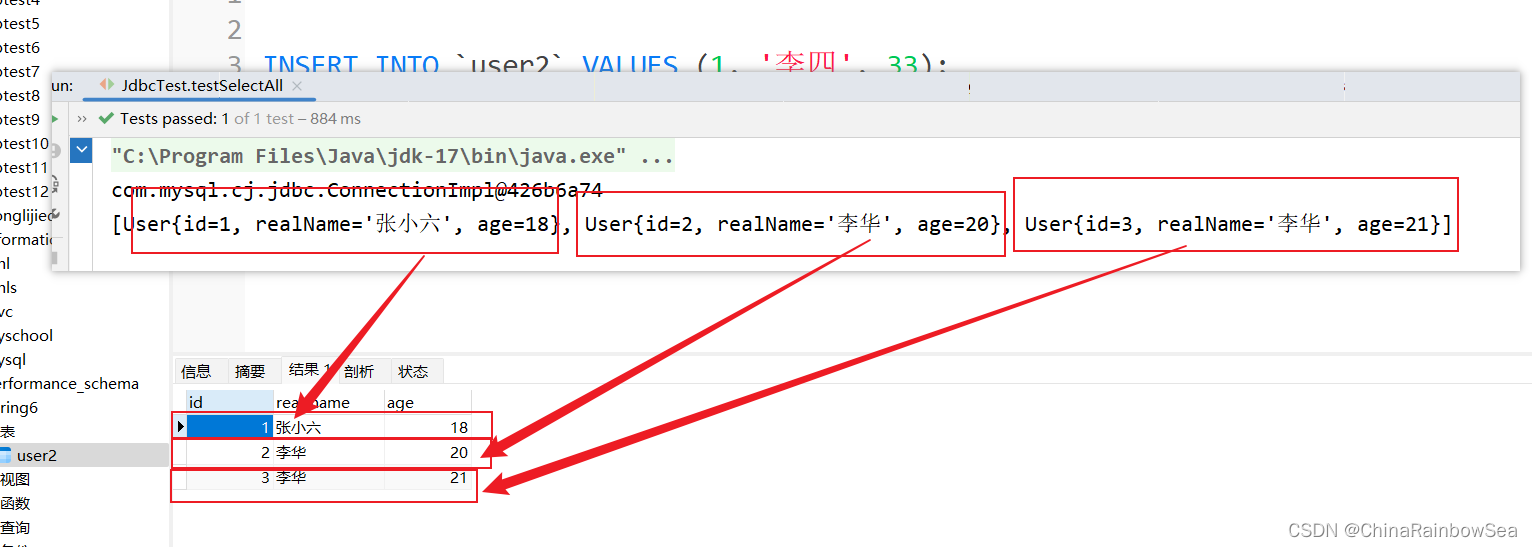
4.7 从数据表中批量添加数据
对于数据表中的批量添加数据,我们这里需要用上:jdbcTemplate.batchUpdate() 方法
第一个参数:String sql 要执行的SQL语句
第二个参数: List<Object[]> batchArgs 是一个List集合当中存储 Object[ ] 数组,注意是数组,这个List 就是,我们批量插入数据时,对于SQL语句当中的
?占位符的传值,因为这个参数是: List<Object[]> batchArgs,所以我们需要将我们 ?占位符的值,放入到List 集合当中,再作为参数,传给jdbcTemplate.batchUpdate() 方法。
- 返回值:就是你各个批量插入的记录的,各个成功的记录条数,比如这里我们批量添加了3条记录,那么如果三条记录都插入成功了的话,就是[1,1,1]。表示每执行一次这个:“insert into user2(real_name,age) values(?,?)”; SQL语句就会影响到一条记录。
插入这条记录,产生了一条记录的影响。
三条记录,各自都是只产生了一条记录的影响

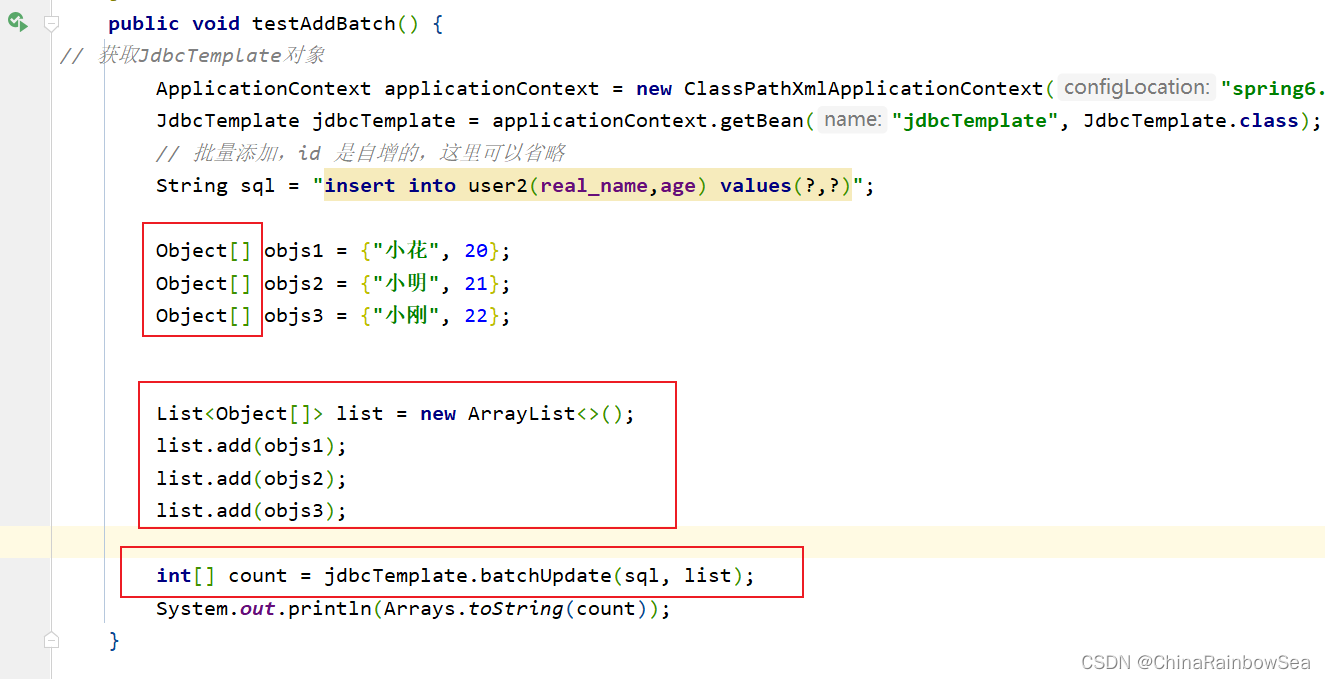
import com.rainbowsea.spring6.bean.User;
import org.junit.Test;
import org.springframework.context.ApplicationContext;
import org.springframework.context.support.ClassPathXmlApplicationContext;
import org.springframework.jdbc.core.BeanPropertyRowMapper;
import org.springframework.jdbc.core.JdbcTemplate;import java.util.ArrayList;
import java.util.Arrays;
import java.util.List;public class JdbcTest {/*** 批量添加数据*/@Testpublic void testAddBatch() {
// 获取JdbcTemplate对象ApplicationContext applicationContext = new ClassPathXmlApplicationContext("spring6.xml");JdbcTemplate jdbcTemplate = applicationContext.getBean("jdbcTemplate", JdbcTemplate.class);// 批量添加,id 是自增的,这里可以省略String sql = "insert into user2(real_name,age) values(?,?)";Object[] objs1 = {"小花", 20};Object[] objs2 = {"小明", 21};Object[] objs3 = {"小刚", 22};// 将要修改的数据封装到 List 集合当中,再作为参数传入List<Object[]> list = new ArrayList<>();list.add(objs1);list.add(objs2);list.add(objs3);int[] count = jdbcTemplate.batchUpdate(sql, list);System.out.println(Arrays.toString(count));}
}
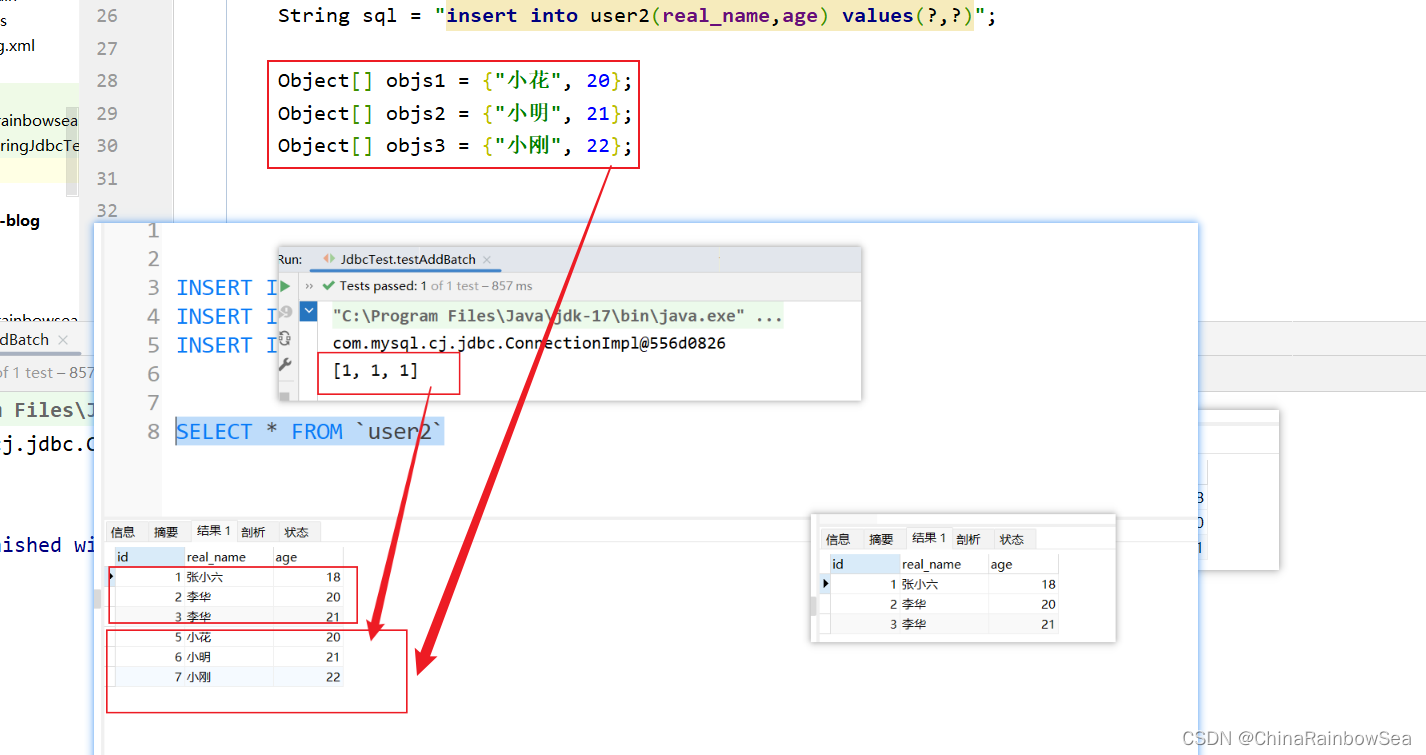
4.8 从数据表中批量修改数据
从数据表中批量修改数据还是使用:jdbcTemplate.batchUpdate() 方法。唯一不同的就是执行的SQL语句不同而已。下面我们将id 为 5,6,7 的 age 改为 10,11,12

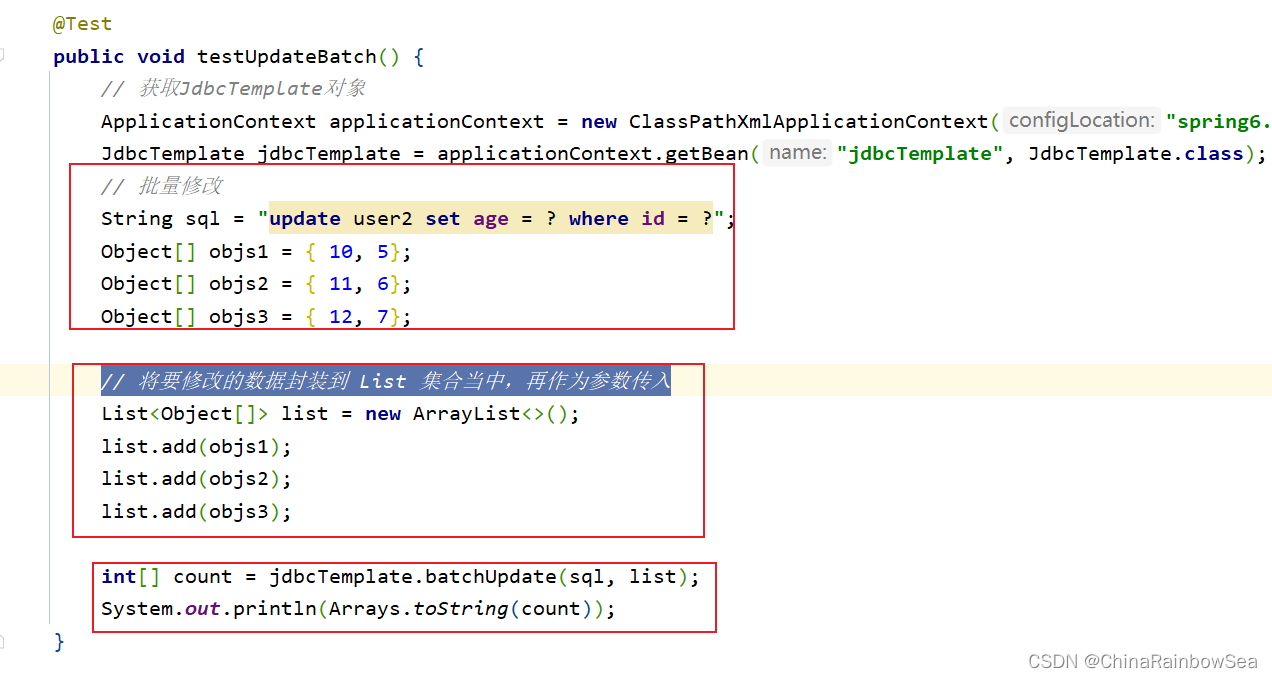
import com.rainbowsea.spring6.bean.User;
import org.junit.Test;
import org.springframework.context.ApplicationContext;
import org.springframework.context.support.ClassPathXmlApplicationContext;
import org.springframework.jdbc.core.BeanPropertyRowMapper;
import org.springframework.jdbc.core.JdbcTemplate;import java.util.ArrayList;
import java.util.Arrays;
import java.util.List;public class JdbcTest {/*** 批量修改*/@Testpublic void testUpdateBatch() {// 获取JdbcTemplate对象ApplicationContext applicationContext = new ClassPathXmlApplicationContext("spring6.xml");JdbcTemplate jdbcTemplate = applicationContext.getBean("jdbcTemplate", JdbcTemplate.class);// 批量修改String sql = "update user2 set age = ? where id = ?";Object[] objs1 = { 10, 5};Object[] objs2 = { 11, 6};Object[] objs3 = { 12, 7};// 将要修改的数据封装到 List 集合当中,再作为参数传入List<Object[]> list = new ArrayList<>();list.add(objs1);list.add(objs2);list.add(objs3);int[] count = jdbcTemplate.batchUpdate(sql, list);System.out.println(Arrays.toString(count));}
}
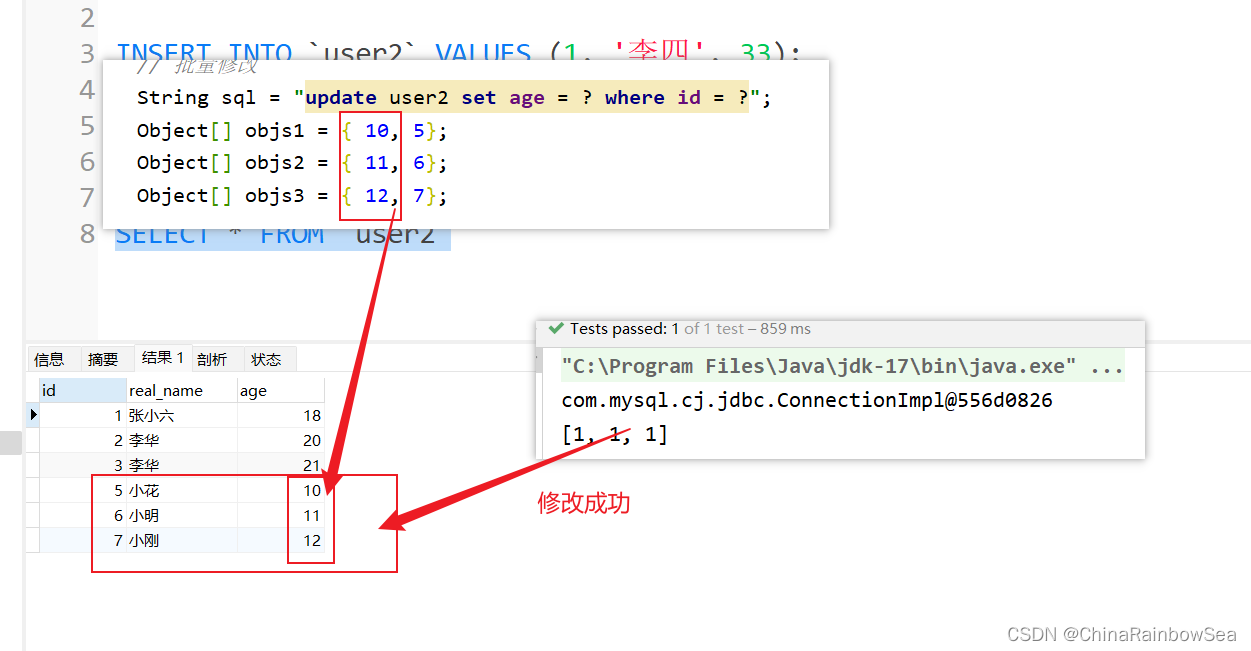
4.9 从数据表中批量删除数据
从数据表中批量删除数据还是使用:jdbcTemplate.batchUpdate() 方法。唯一不同的就是执行的SQL语句不同而已。下面我们将user 数据表中的 id 为 5,6,7 的记录删除了。
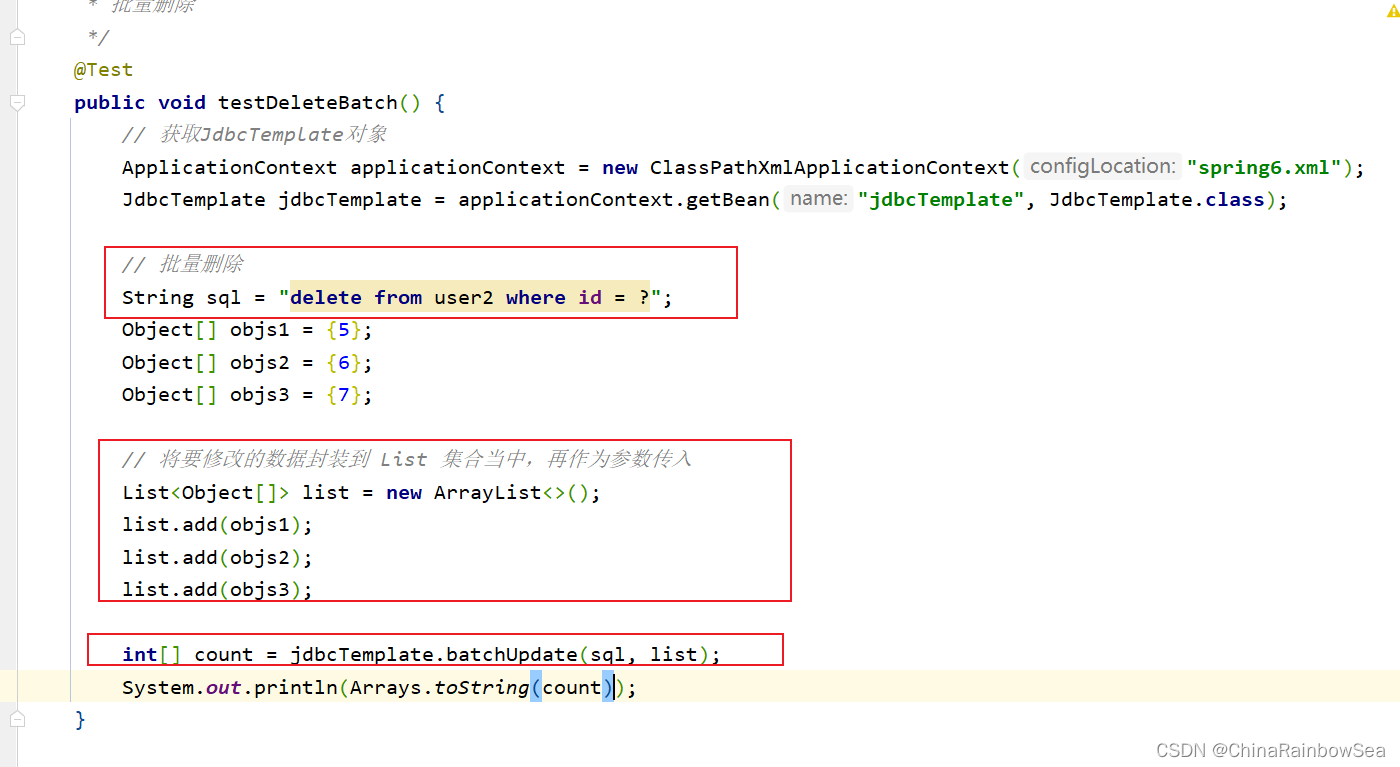
import com.rainbowsea.spring6.bean.User;
import org.junit.Test;
import org.springframework.context.ApplicationContext;
import org.springframework.context.support.ClassPathXmlApplicationContext;
import org.springframework.jdbc.core.BeanPropertyRowMapper;
import org.springframework.jdbc.core.JdbcTemplate;import java.util.ArrayList;
import java.util.Arrays;
import java.util.List;public class JdbcTest {/*** 批量删除*/@Testpublic void testDeleteBatch() {// 获取JdbcTemplate对象ApplicationContext applicationContext = new ClassPathXmlApplicationContext("spring6.xml");JdbcTemplate jdbcTemplate = applicationContext.getBean("jdbcTemplate", JdbcTemplate.class);// 批量删除String sql = "delete from user2 where id = ?";Object[] objs1 = {5};Object[] objs2 = {6};Object[] objs3 = {7};// 将要修改的数据封装到 List 集合当中,再作为参数传入List<Object[]> list = new ArrayList<>();list.add(objs1);list.add(objs2);list.add(objs3);int[] count = jdbcTemplate.batchUpdate(sql, list);System.out.println(Arrays.toString(count));}
}
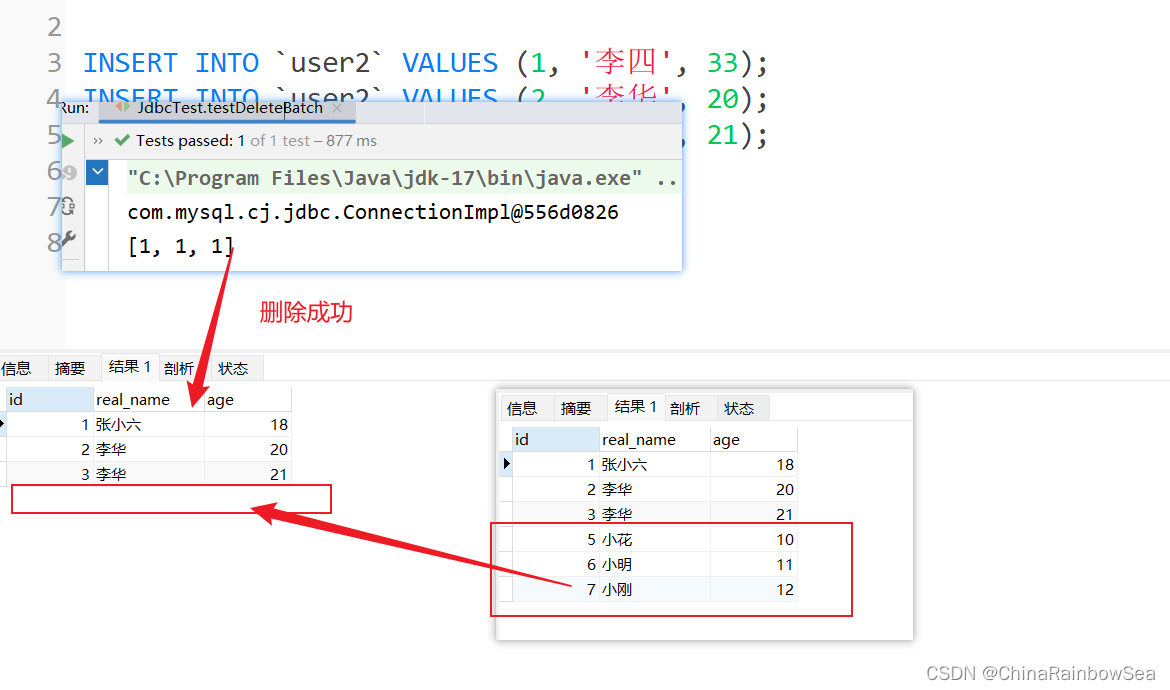
4.10 JdbcTemplate 使用回调函数
使用回调函数,可以参与的更加细节:例如:如果你想写JDBC代码,可以使用callback回调函数
想要执行回调函数,用使用上 jdbcTemplate.execute() 方法,

- 第一个参数是:String sql 要执行的SQL语句
- 第二个参数是:PreparedStatementCallback action ,是个接口,我们要传其实例化对象,
PreparedStatementCallback,一般我们通常是使用 lambda 表达式 ,简化代码。
需要注意的是:注册回调函数,当execute 方法执行的时候,回调函数中的doInPreparedStatement()会被调用
- 返回值:就是这里运用的泛型,返回值,就是你传的 T.class 的 Bean 对象。
这里我们使用回调函数,查询 user 数据表中 id 为 2的 用户的,id, real_name,age 的记录信息
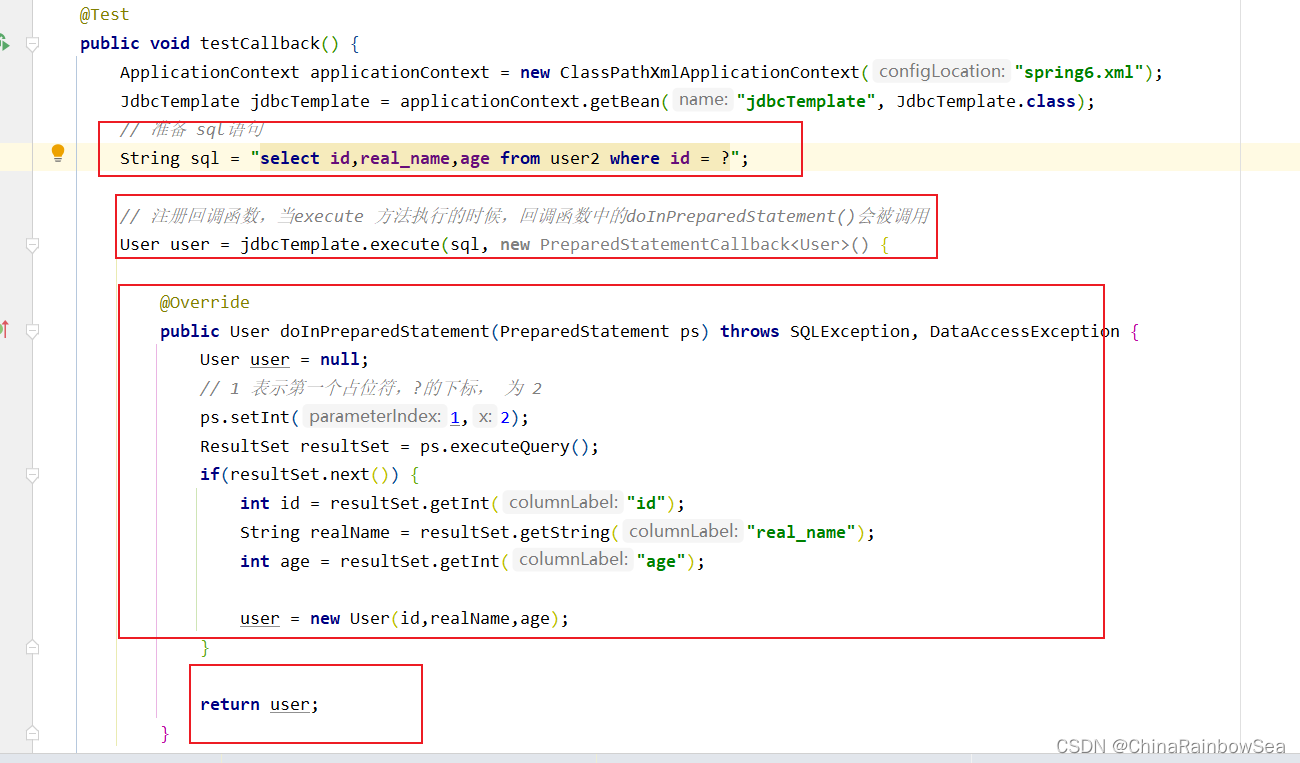
import com.rainbowsea.spring6.bean.User;
import org.junit.Test;
import org.springframework.context.ApplicationContext;
import org.springframework.context.support.ClassPathXmlApplicationContext;
import org.springframework.dao.DataAccessException;
import org.springframework.jdbc.core.BeanPropertyRowMapper;
import org.springframework.jdbc.core.JdbcTemplate;
import org.springframework.jdbc.core.PreparedStatementCallback;import java.sql.PreparedStatement;
import java.sql.ResultSet;
import java.sql.SQLException;
import java.util.ArrayList;
import java.util.Arrays;
import java.util.List;public class JdbcTest {/*** 回调函数* 如果你想写JDBC代码,可以使用callback回调函数*/@Testpublic void testCallback() {ApplicationContext applicationContext = new ClassPathXmlApplicationContext("spring6.xml");JdbcTemplate jdbcTemplate = applicationContext.getBean("jdbcTemplate", JdbcTemplate.class);// 准备 sql语句String sql = "select id,real_name,age from user2 where id = ?";// 注册回调函数,当execute 方法执行的时候,回调函数中的doInPreparedStatement()会被调用User user = jdbcTemplate.execute(sql, new PreparedStatementCallback<User>() {@Overridepublic User doInPreparedStatement(PreparedStatement ps) throws SQLException, DataAccessException {User user = null;// 1 表示第一个占位符,?的下标, 为 2ps.setInt(1,2);ResultSet resultSet = ps.executeQuery();if(resultSet.next()) {int id = resultSet.getInt("id");String realName = resultSet.getString("real_name");int age = resultSet.getInt("age");user = new User(id,realName,age);}return user;}});System.out.println(user);}
}
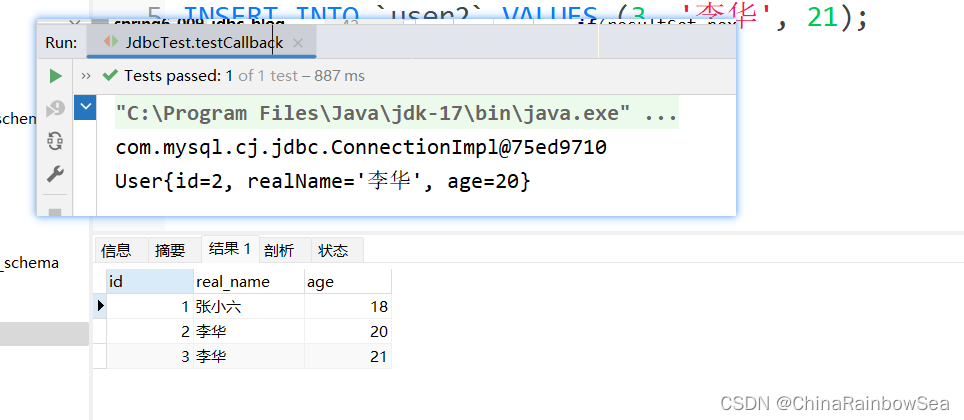
4.11 JdbcTemplate 配合使用上德鲁伊连接池
上面演示的是用我们自己写的数据源。这里我们其实也是可以使用别人写好的。例如比较牛的德鲁伊连接池。
第一步:引入德鲁伊连接池的依赖。(毕竟是别人写的,我需要导入,才能使用),使用 maven 导入。
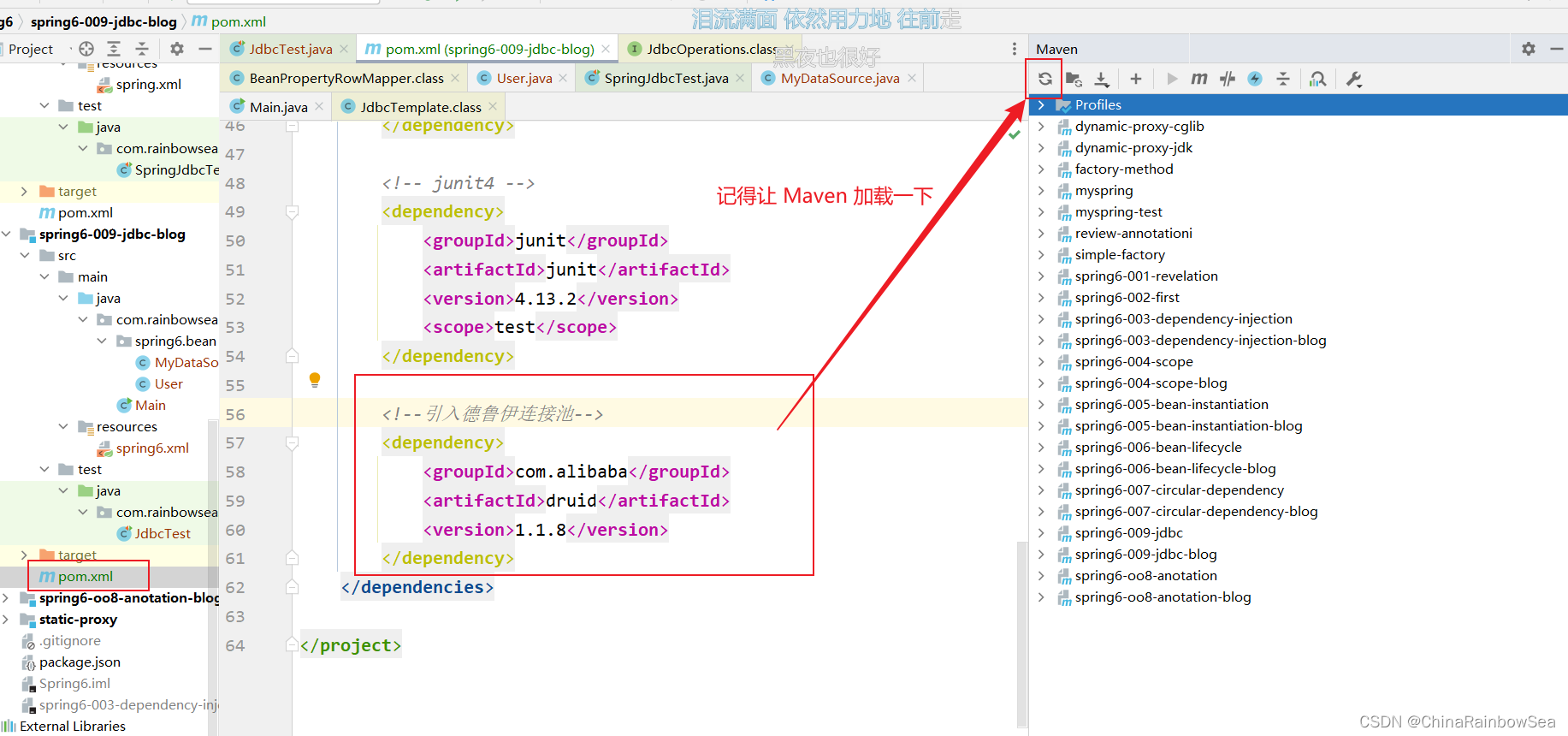
<!--引入德鲁伊连接池--><dependency><groupId>com.alibaba</groupId><artifactId>druid</artifactId><version>1.1.8</version></dependency>
第二步:将德鲁伊中的数据源配置到 spring.xml 配置文件中。和配置我们自己写的一样。就是一些:对应数据库的注册驱动,指明数据库的所在位置,以及连接数据库的账号和密码。
需要特别注意的是:注意这里是:driverClassName,是简单类型进行set注入对属性赋值,简单类型可以用 value
而如果是使用:driver,用 ref了
这里我们用:driverClassName,进行简单类型的set 注入,对 this.driver 成员变量的属性赋值。
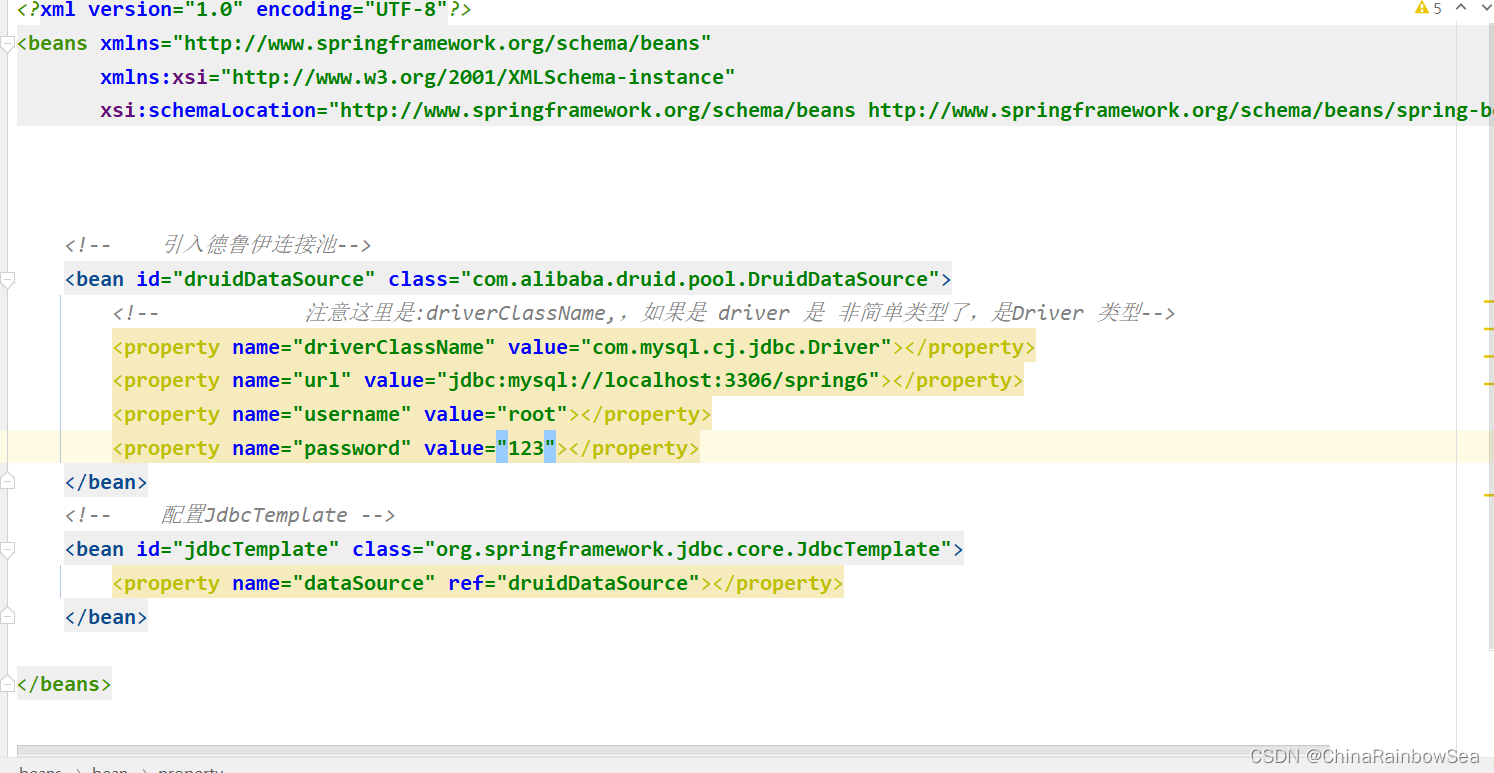
<?xml version="1.0" encoding="UTF-8"?>
<beans xmlns="http://www.springframework.org/schema/beans"xmlns:xsi="http://www.w3.org/2001/XMLSchema-instance"xsi:schemaLocation="http://www.springframework.org/schema/beans http://www.springframework.org/schema/beans/spring-beans.xsd"><!-- 引入德鲁伊连接池--><bean id="druidDataSource" class="com.alibaba.druid.pool.DruidDataSource"><!-- 注意这里是:driverClassName,,如果是 driver 是 非简单类型了,是Driver 类型--><property name="driverClassName" value="com.mysql.cj.jdbc.Driver"></property><property name="url" value="jdbc:mysql://localhost:3306/spring6"></property><property name="username" value="root"></property><property name="password" value="123"></property></bean><!-- 配置JdbcTemplate --><bean id="jdbcTemplate" class="org.springframework.jdbc.core.JdbcTemplate"><property name="dataSource" ref="druidDataSource"></property></bean></beans>
下面,我们测试,使用德鲁伊数据库连接池,进行对数据库的查询:
查询id 为1的一条记录。
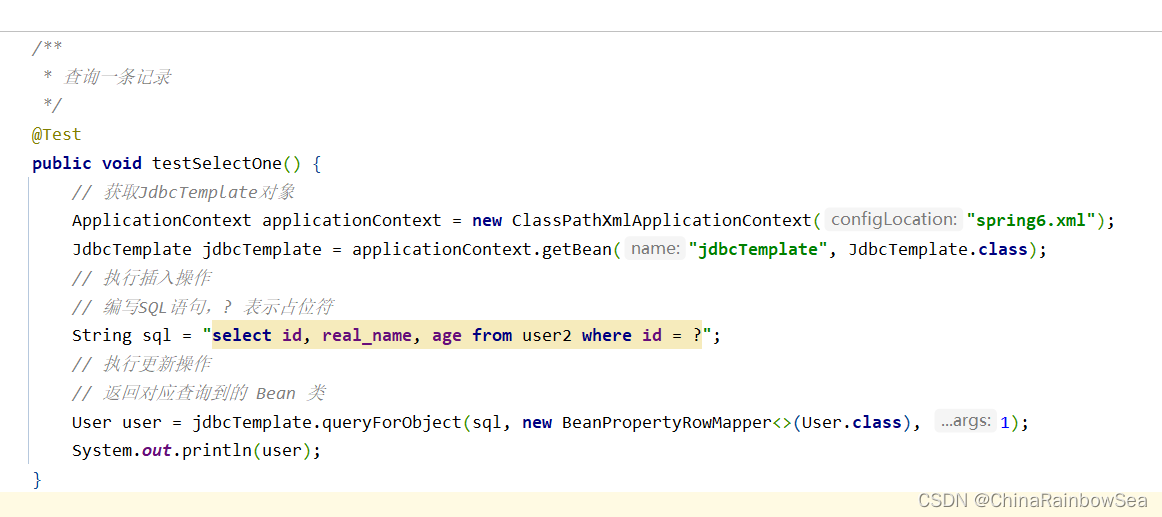

查询成功。
我们再使用德鲁伊进行多个数据的查询。同样也是没有问题的。

5. 总结:
JdbcTemplate 是Spring 提供的一个JDBC模板类,是对JDBC的封装,简化JDBC代码,当然,你也可以不用,可以让Spring集成其它的ORM框架,例如:MyBatis,Hibernate 等。
使用JdbcTemplate 需要导入的如下 jar依赖
1. spring context 依赖 (spring6 的依赖) 2. mysql-connector-java(关于MySQL驱动的依赖,因为我们要连接数据库,这里我们连接的是MySQL数据库) 3. spring-jdbc (spring jdbc,这个依赖中有JdbcTemplate) 4. junit (Junit4 单元测试依赖)在Spring当中的JdbcTemplate,对于数据库上的增删改,执行SQL语句都是使用
update()的方法处理的。关于查询一条记录,使用 jdbcTemplate.queryForObject() 方法:
查询数据表中的多个对象,我们就要使用:jdbcTemplate.query() 方法了
查询数据表当中有几条记录,对应查询数据表中的一个值的内容,我们同样还是使用:jdbcTemplate.queryForObject() 方法来进行。不同的是,这个参数是两个的,是对应的类对象。需要注意的第二个参数,使用的是:对应返回类型的 T.class 类
使用回调函数,可以参与的更加细节:例如:如果你想写JDBC代码,可以使用callback回调函数
想要执行回调函数,用使用上 jdbcTemplate.execute() 方法, 需要注意的是:注册回调函数,当execute 方法执行的时候,回调函数中的doInPreparedStatement()会被调用
对于数据表中的批量添加删除修改数据,我们这里需要用上:jdbcTemplate.batchUpdate() 方法
6. 最后:
“在这个最后的篇章中,我要表达我对每一位读者的感激之情。你们的关注和回复是我创作的动力源泉,我从你们身上吸取了无尽的灵感与勇气。我会将你们的鼓励留在心底,继续在其他的领域奋斗。感谢你们,我们总会在某个时刻再次相遇。”
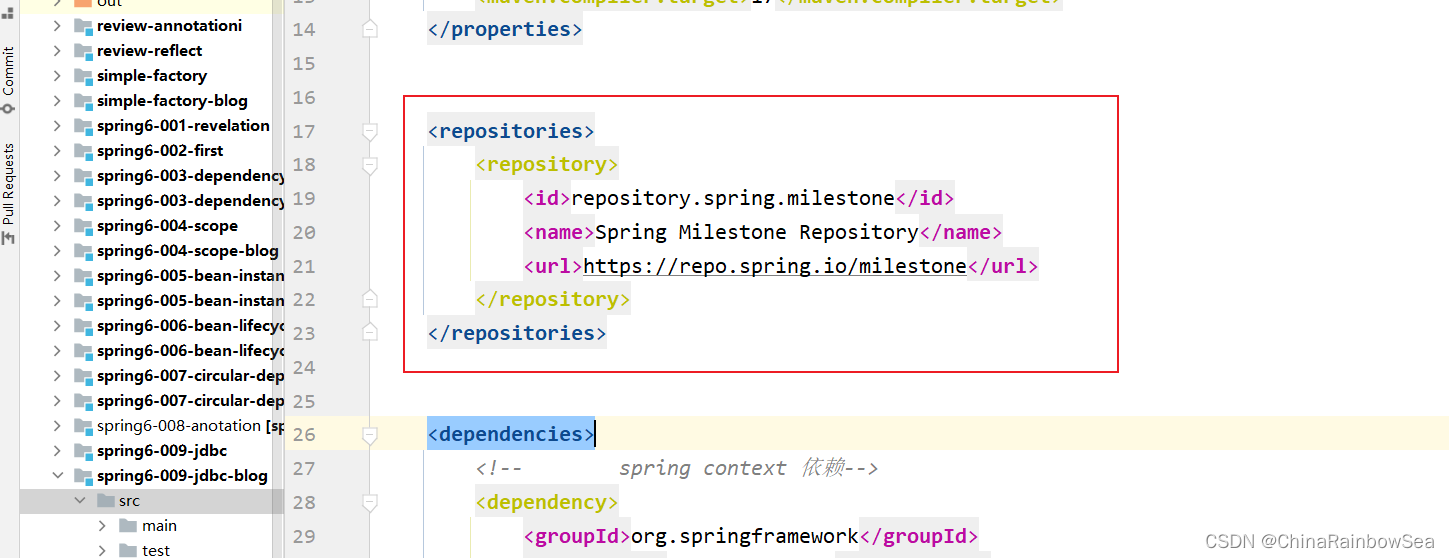





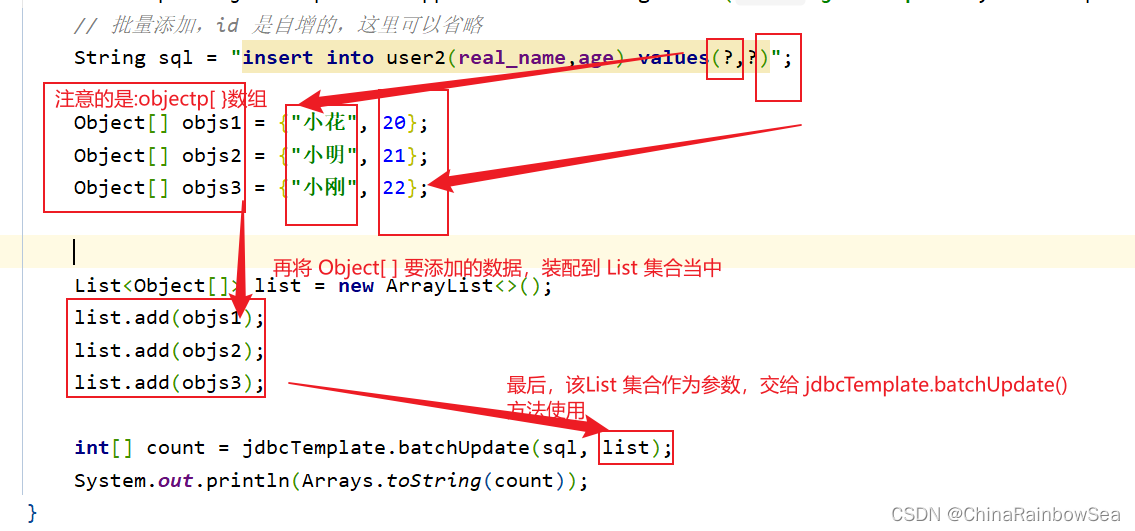
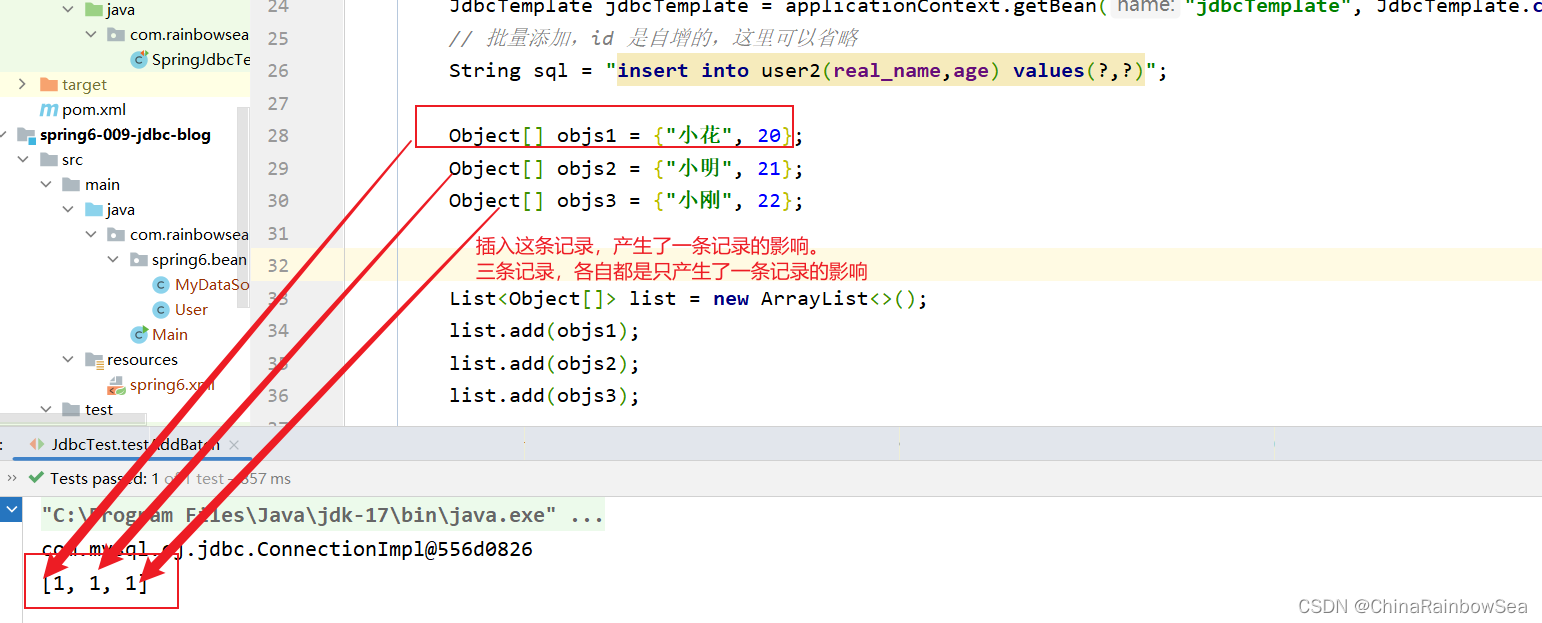


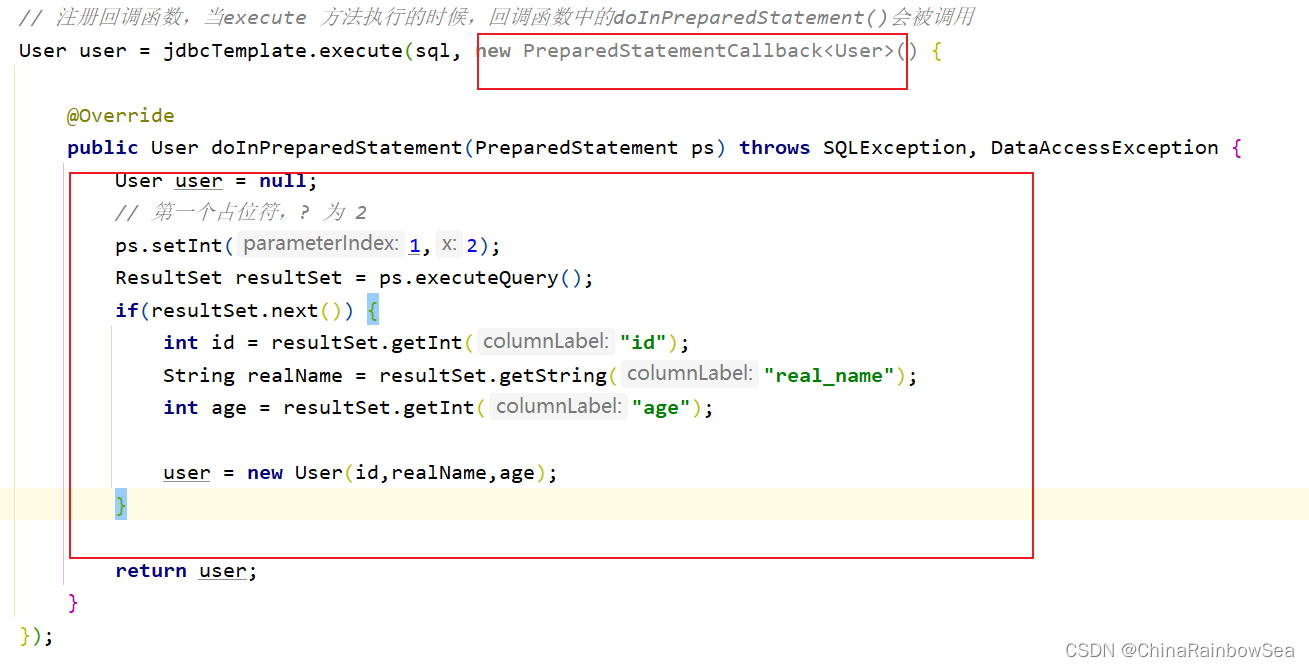
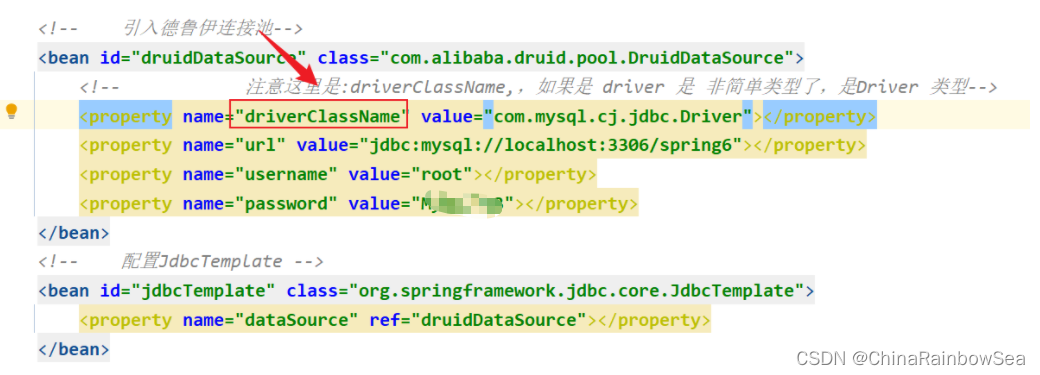
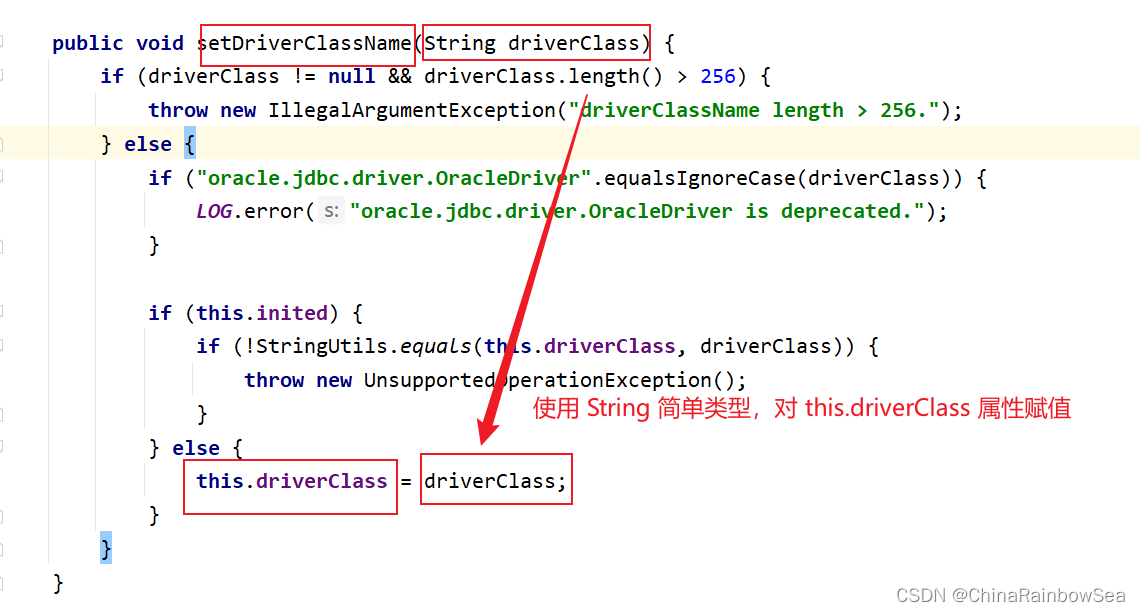





)


)









--学习笔记【第5章:信息系统工程】)



